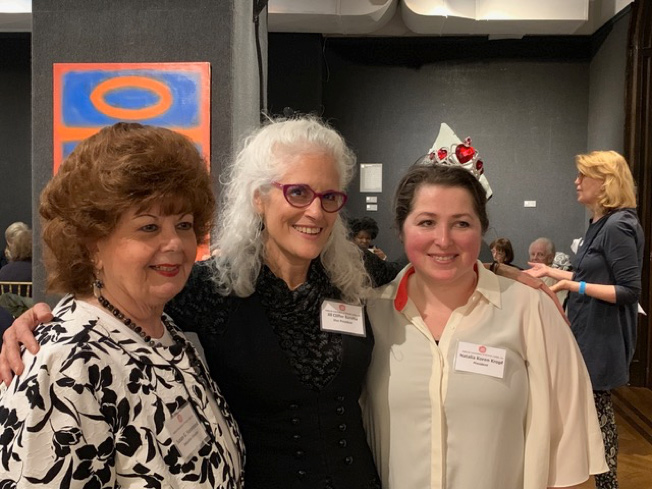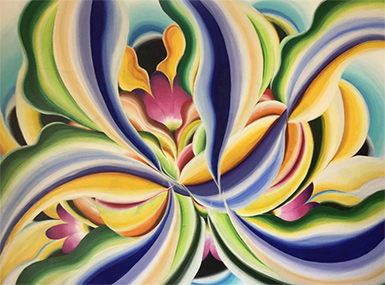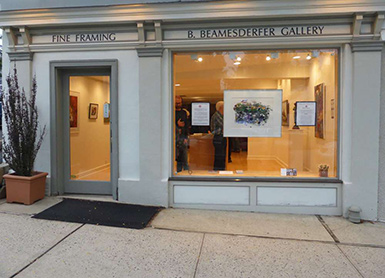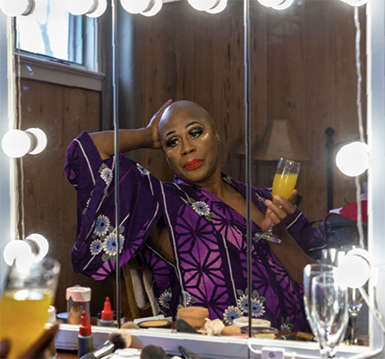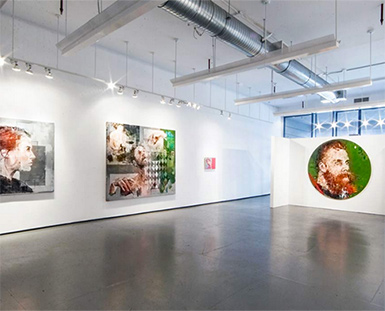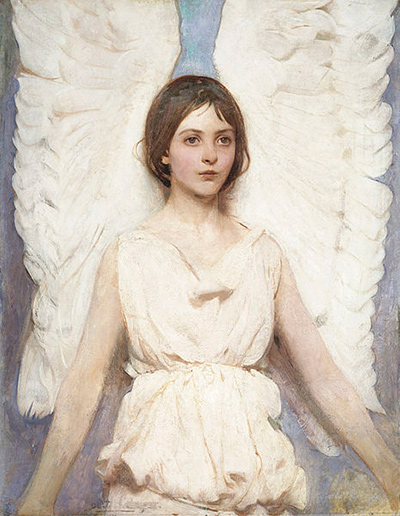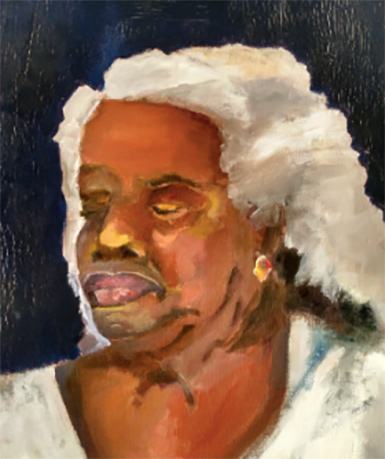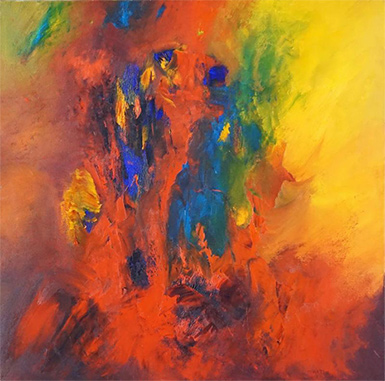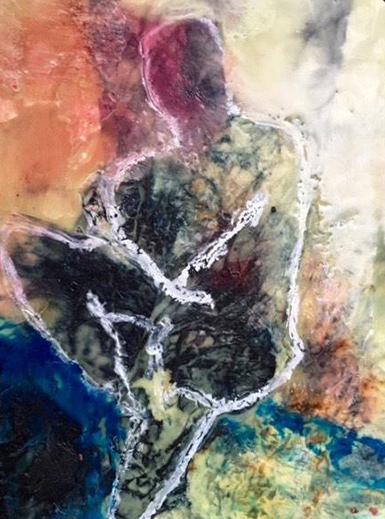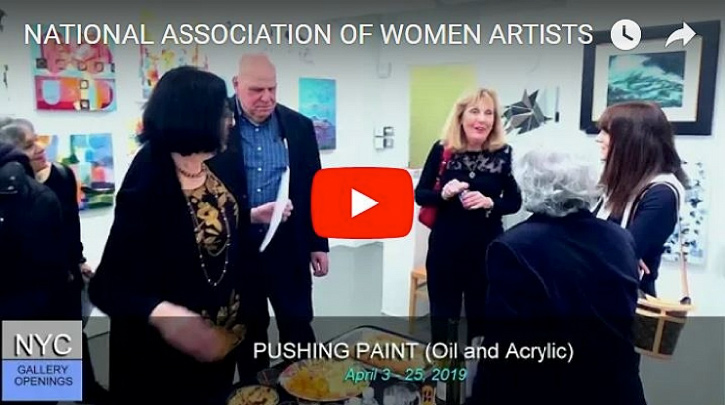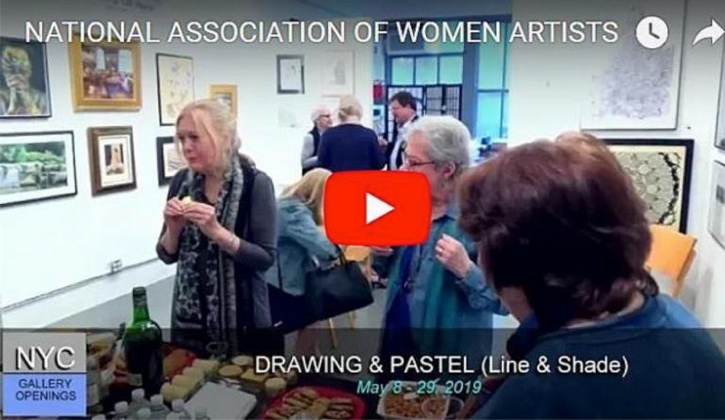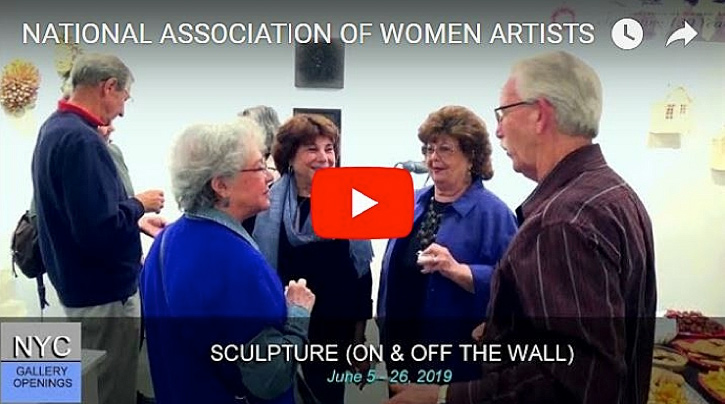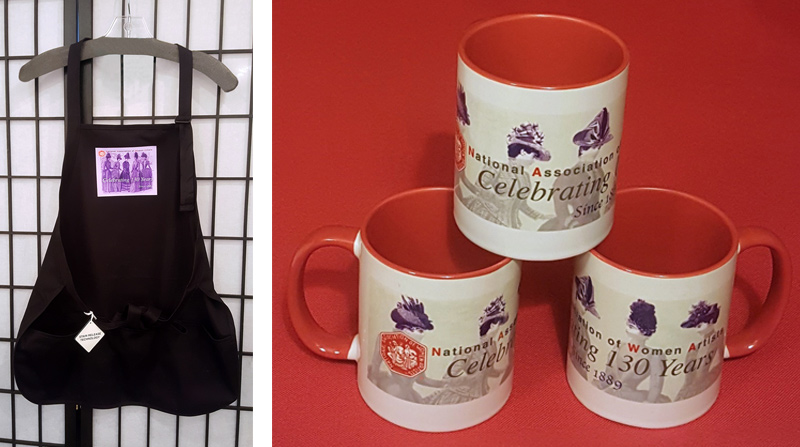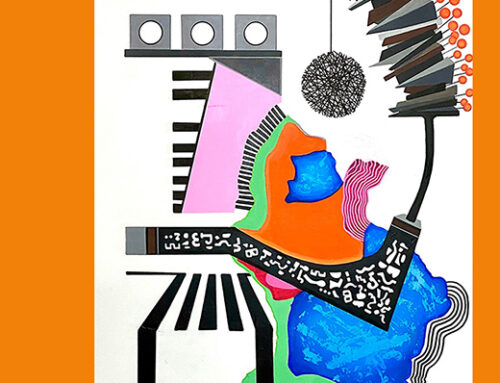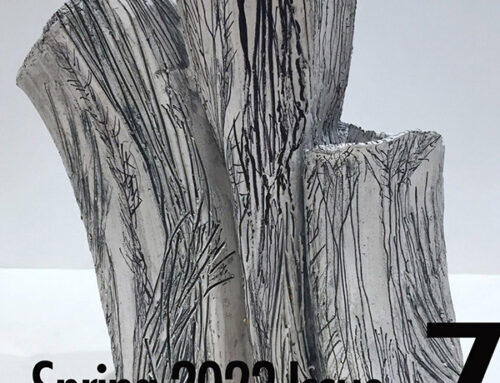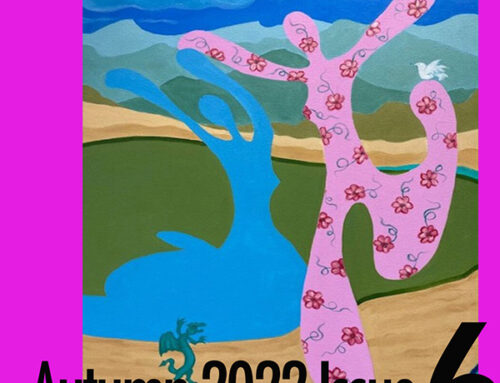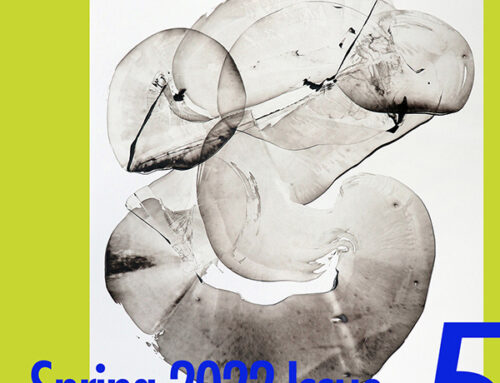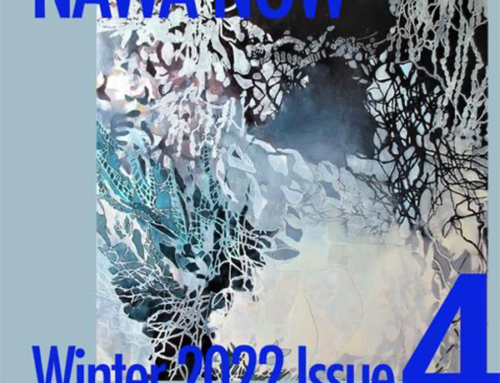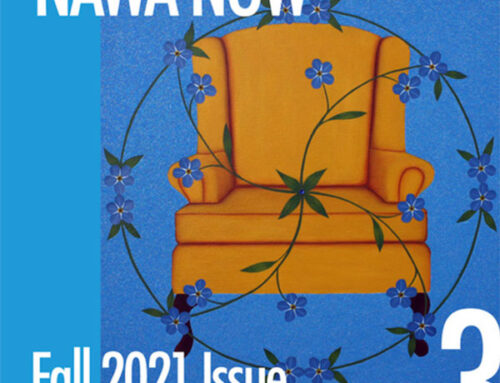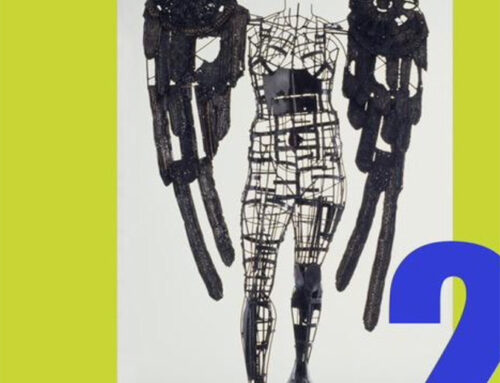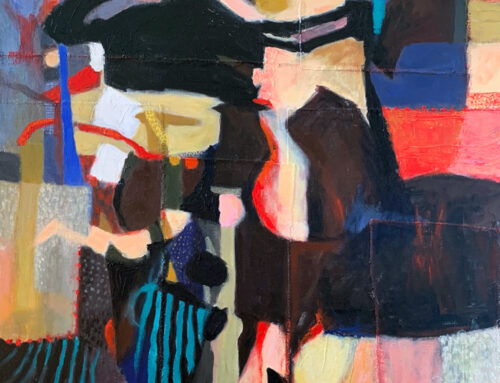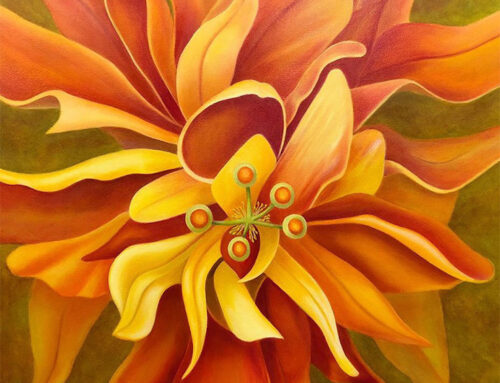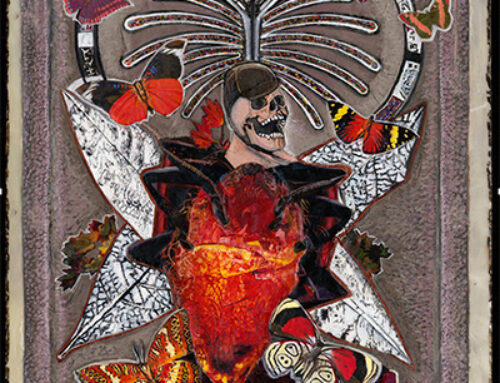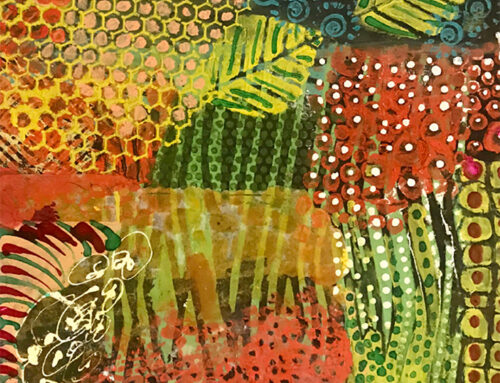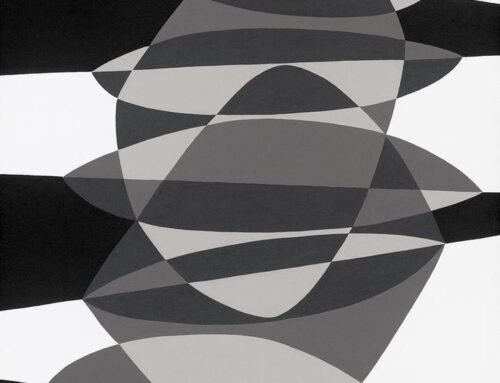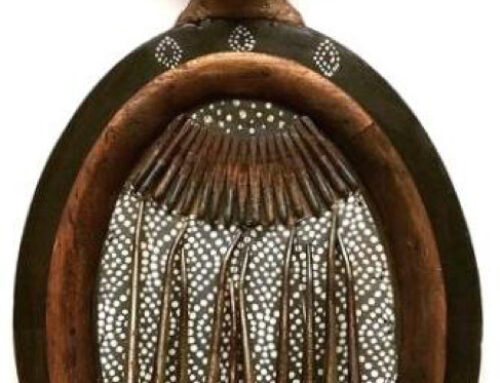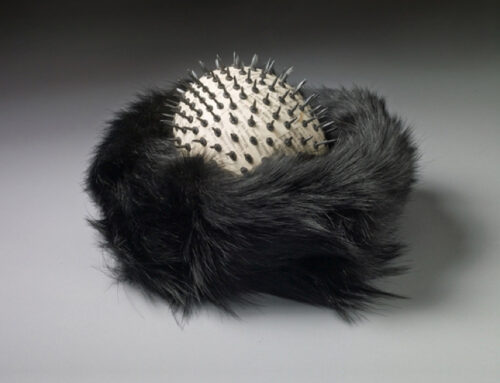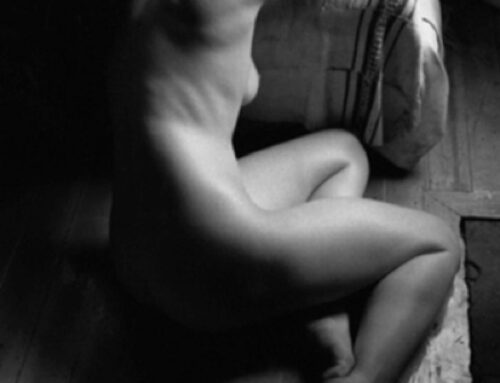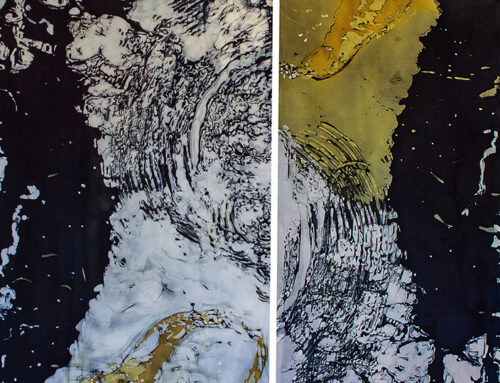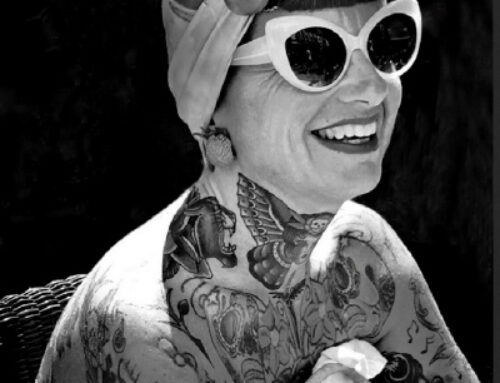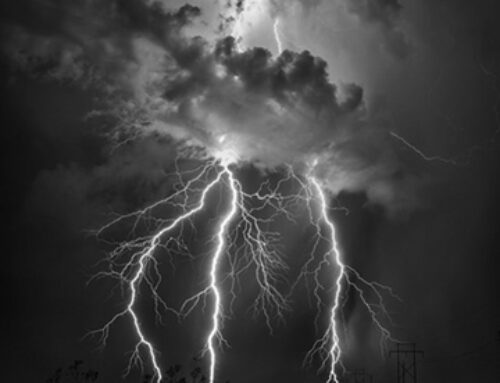
July 2019
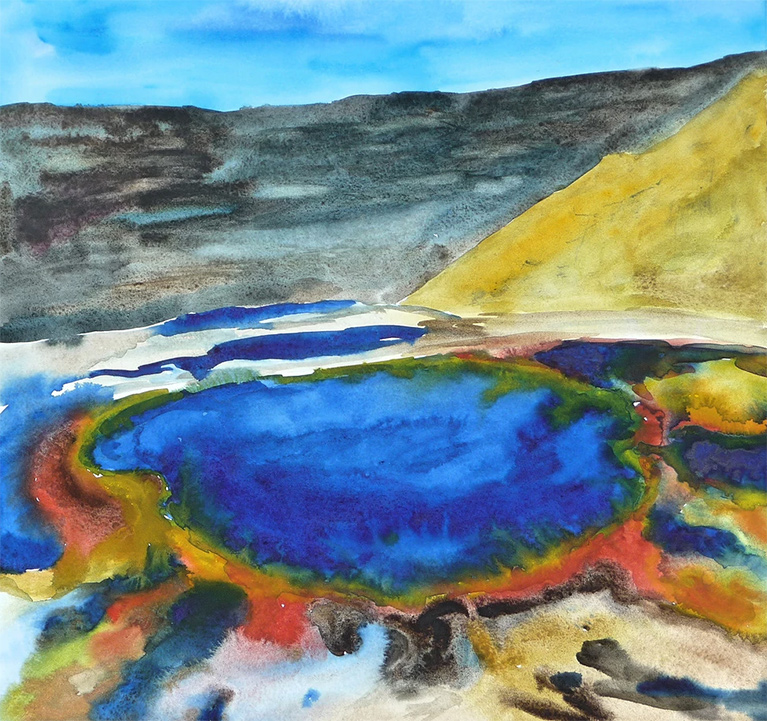
Lisa Goren, Hot Springs, Iceland, Watercolor on mounted board, 18 x 18 in.
ABOUT Hot Springs, Iceland
Hot Springs, Iceland is a watercolor on paper mounted to board. The subject, unusual for me because it’s actually hot, is found on Iceland where hot and cold coexist in magical ways. A few hours’ drive from the spring, you can be standing on a glacier with thousand year-old ice.
Wet-on-wet is the watercolor technique used to create Hot Springs, Iceland. It is not the pristine, delicate process that many associate with the medium. By pouring and manipulating the water on the paper, the effects are unlike any that people often associate with watercolors. You get wet and you get messy. But you get amazing results
PRESIDENT’S CORNER
Reflections on NAWA Presidency
By Jill Cliffer Baratta
Thoughts on leaving the NAWA presidency behind: I could have just been a figurehead and taken my crown, posturing, throwing my title around, and enjoying the status. That would have been, perhaps, a fun run. However, I was selected as a candidate for president because I spoke up, dug in, and acted for the association where I saw needs (including but not limited to cleaning the closet and taking out the trash. Ask Susan!).
I realize that my position for being able to do the “speak-up, dig-in, and act-for,” was somewhat unusual. My children are grown, working and pulling their own weight in their own places. I have no living parents, in-law parents, or grandchildren (yet!). I have a part time paying job that involves limited hours of engagement and is very satisfying. And I am strong and healthy. All of that, plus my overall family’s income, allowed me to have the freedom to devote time and energy to NAWA.
The two years of my NAWA presidency were very intense, with hours invested sometimes being close to (or surpassing) full-time. Of course, it is a volunteer position. I liked to say “It keeps me out of trouble.” I took a lot of responsibility—inheriting the Awards program, which I had to figure out with little help; I directed more than the two Annual Exhibitions that fell within my presidency, oversaw the committees and presided over the Operating and Executive Board meetings. I tried very hard to improve communication within the Association. The latter is very challenging because there is only one full-time employee and three part-time staff who are in the office mostly at different times. For the right hand to know what the left hand is doing, as they say, is somewhat challenging. This was not completely under my control, but I made strong efforts to influence that culture. I feel this is one of the most essential elements for a smooth-running organization, especially with people coming and going on sometimes irregular schedules.
NAWA’s 130th year has been an exciting one. We started with that lovely skit that Sandra Bertrand wrote and for which Natalia Koren-Kropf found us such perfect costumes. Those present truly enjoyed it (also those who viewed the YouTube). We have been selling the commemorative mugs and aprons, making almost $1000 net profit (will reach or exceed that by year end) and sharing the amazing accomplishment of surviving 130 years as a group of women artists! The mug & apron sale initiative was mostly spearheaded by me with designing help by Julie Castillo, who prepped all the artwork. It has been fun running this small side business for NAWA.
I want to thank Susan Hammond for her expertise, her support, her friendship, and sense of humor. She always goes above and beyond the call of duty and should be recognized as a strong lynchpin of NAWA for the past well—many years. I also thank all the employees for their continued dedication and efforts on behalf of NAWA.
I have great expectations for a vibrant and exciting finish to this 130th Anniversary year, and wish Natalia and everyone the best for running our dear NAWA! I am staying on as Vice President, so not going away any time soon (but I might be on vacation)!! I will also continue to serve as Awards Chair until I can find someone who can handle this very complex and important position. Please contact me if you are interested.
Again, thanks to Susan, the staff, the Boards, all the committee heads, and especially to every member, for whom all this effort exists. Create! Onward!
Jill Cliffer Baratta
Vice President, Awards Chair, NAWA
NAWA – THE EARLY YEARS (1969-1990)
Information from One Hundred Years – A Centennial Celebration of the National Association of Women Artists
By Susan G. Hammond
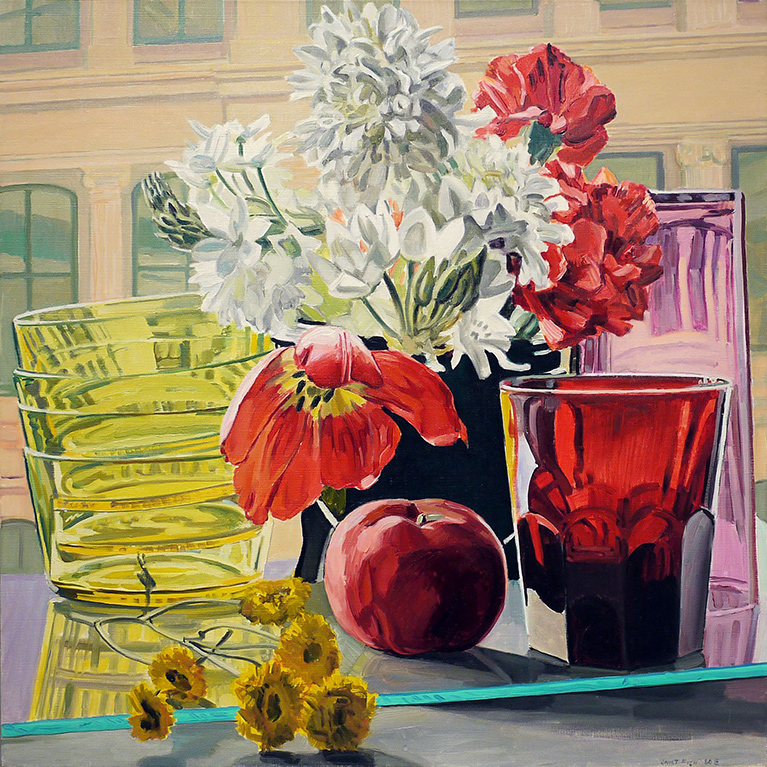
Janet Fish, Tulip, Apple and Glass, 1980, Oil on canvas, 38 x 38 in.
The National Association of Women Artists participated in the Women’s 1969 International Art Exhibition and Competition in Cannes, France, from February 1-23. Twenty-one countries competed for awards, and of the 13 prizes offered, six were presented to National Association of Women Artists members in addition to honorable mentions. The Paris paper Le Figaro, in reviewing this show, proclaimed “the American art notably surpassed the others.” In Cannes, Nice-Matin reported that “The judges found it difficult to evaluate the comparative qualities of the American collection, it was so overwhelmingly superb.”
During the 1970s, the National Association of Women Artists continued its policy of circulating traveling shows abroad, including one of oils and graphics sent to Italy in 1972.
The year 1975 was designated International Women’s Year by the United Nations. New York City Mayor Abraham Beame declared the day of NAWA’s spring luncheon National Association of Women Artists Day in recognition of the organization’s contributions. All of their exhibitions that year, both national and international, were dedicated to International Women’s Year, but as NAWA’s newsletter reported in December, “To us, every year is one in which the interests of women, and specifically women artists, are advanced.”
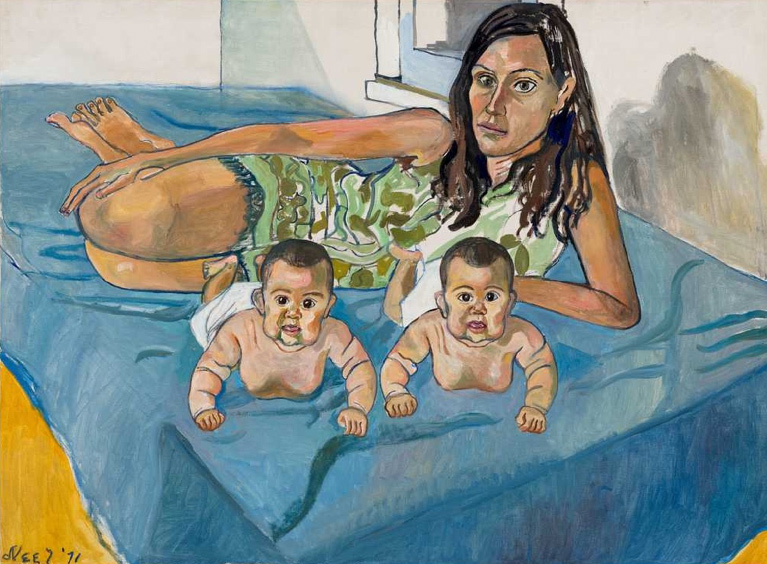
Alice Neel, Nancy and the Twins (5 mos.) Oil on canvas, 1971.
In 1976, NAWA celebrated the nation’s bicentennial by sponsoring historic lectures: “Rediscovery of the American 19th Century Woman Artist,” by Mildred Thaler, owner of the Marbella Gallery in New York and “Roots from Which We Spring” given by Rose Schaffer, a member of NAWA.
In the introductory essay for NAWA’s 1977 annual exhibition held at the National Academy of Design, president Elizabeth Horman reported that there were over 700 members representing forty-one states whose works of art were featured not only in this exhibition but in major shows at Citibank, Union Carbide and Equitable Life Assurance Society as well as traveling shows throughout the U.S.
The year 1979 started out on a negative note for NAWA when the Association was informed that after 33 years of holding its annual exhibition at the National Academy of Design, the contract, along with those of almost all other art organizations that used the space, would not be renewed. However, the ever resourceful group set out to find an alternative, and they managed to secure a space in the Federal Building at 26 Federal Plaza. Because of this new audience, NAWA sold more art works than at the previous ten annuals.
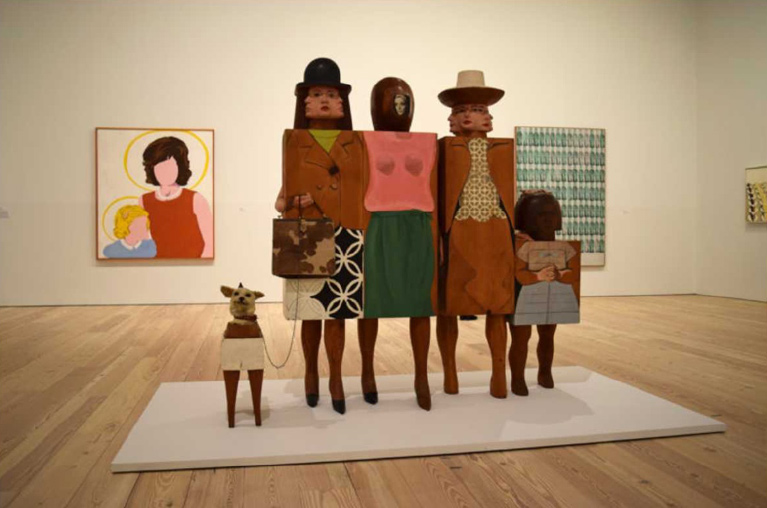
Marisol, Women and Dog, 1963, Photo: Benjamin Dutton/Hyperallergic.
During the 1980s, NAWA invited several distinguished artists to become honorary vice-presidents of the organization, thereby lending the support of their names and reputations to the general cause of women artists that NAWA represented. Among those invited were Isabel Bishop and Alice Neel (1983); Dorothy Dehner and Louise Nevelson (1984); Nell Blaine, Judy Chicago, Janet Fish and Marisol Escobar (1987); and Minna Citron (1988). Citron had exhibited with NAWA as early as 1943 and Nevelson as early as 1952.
The decade of the 80s began with a report of that year’s activity in the December issue of the N.A.W.A. News, which included exuberant praise for Judy Chicago’s extravaganza, The Dinner Party. The Dinner Party was lauded by NAWA as a valiant undertaking that took 5 years to produce and utilized the skills of 400 artists and other workers led by the vision of Judy Chicago.
In 1981, Mayor Edward Koch proclaimed April 30th the “National Association of Women Artists Day” in recognition of the expanding opportunities this organization helped to achieve for women artists over the past 92 years.
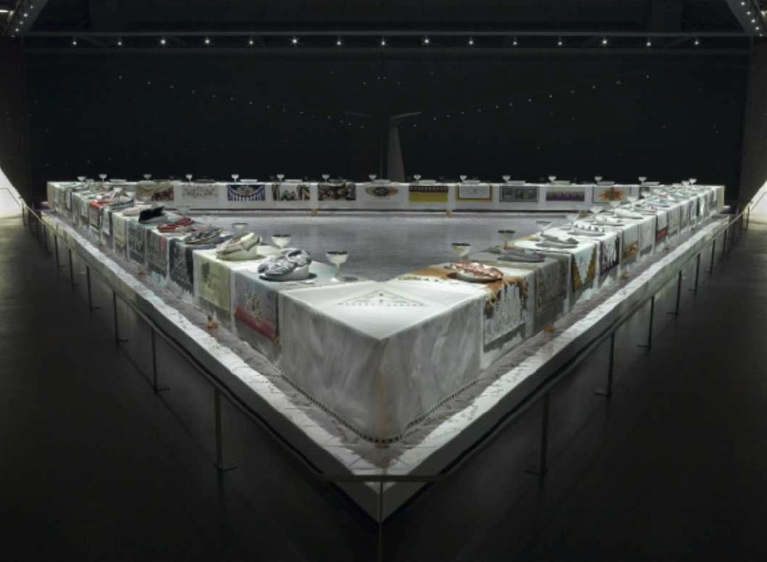
Judy Chicago, The Dinner Party, 1974, Brooklyn Museum, Gift of the Elizabeth A. Sackler
Foundation, Photo: Donald Woodman.
In 1985, President Catherine “Catchie” Childs presented a check for $1,000 to Wilhelmina Cole Holladay, Director of the National Museum of Women in the Arts, Washington, DC, at the Carlyle Hotel, New York City. It was the first installment of the $5,000 to be raised for NAWA to become a founding member organization of that institution. Ms. Holladay was NAWA’s guest speaker at their annual spring luncheon on April 23, 1985, at which time she was presented with the remaining $4,000 of the organization’s pledge.
In 1987, the N.A.W.A. News continued to report on the association’s activities and accomplishments, and it was announced that NAWA had received a Proclamation from the Mayor of New York City in honor of the exhibition of member artists sent to Puerto Rico. The exhibition was held at the Condado Plaza Hotel’s Galeria San Jeronimo, March 5-25th. Also that year former president Catchi Childs, current president Ann Pellaton and Aurura Dias-Jorgensen represented NAWA at the opening events of the National Museum of Women in the Arts.
In January 1989, the National Association of Women Artists celebrated 100 years of service to women artists. To celebrate this centennial, President Liana Moonie and the Board planned two exhibitions: a traveling exhibition of contemporary artists with the theme of 100 Years/100 Artists that traveled throughout the U.S., as well as a traveling exhibition to India.
RED CARPET — OUR NEW PRESIDENT
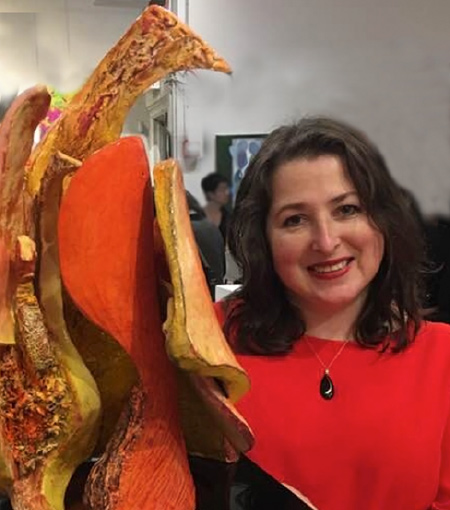
Natalia Koren Kropf with her sculpture titled FireBird.
NATALIA KOREN KROPF
On a promising spring morning in May, I met our incoming NAWA president Natalia Koren Kropf at the Art Students League on 57th Street in Manhattan where she is currently engaged in a sculpture workshop. We moved to a nearby coffee shop for lunch, where we quickly got down to the business at hand. I found Natalia to be warm, ebullient, honest, and always generous in her responses. – Sandra Bertrand
SB: First thing I wanted to ask you might be more exotic for our readers than for you. But in your early years growing up in St. Petersburg, Russia, what was that like for you? What influences from your childhood led you on a creative path? What was it primarily family, friends, and your neighborhood?
NK: I was drawing, as far as I can remember, from a very early age. My grandfather was very supportive. He always encouraged me to keep drawing and told my mom to keep my drawings. I remember that I drew people with three eyes. And my grandfather told me later that it was interesting that I consistently drew people that way, that it was a sign of a spiritual awakening. My grandfather was a kind, gently mannered, well-educated man with an extraordinarily, inquiring mind in both arts and sciences. He was an engineer and an inventor, spoke several languages, could draw and paint, and had a beautiful tenor voice. He designed and built our summer house, dacha, outside of St. Petersburg where we spent our family summers.
My grandfather, Eugene, was my first and most influential teacher.
SB: Your early schooling?
NK: At age 11, I was admitted into St. Petersburg Academy of Fine Art’s seven-year preparatory program for children. I then continued my studies at the Academy of Fine Arts, formally known as Repin St. Petersburg State Academic Institute for Painting, Sculpture and Architecture, founded in 1757. The program was intense and highly competitive. The classes run from 9:30 am until 5:30 pm, with three to six hours of studio time daily. The curriculum included art history, painting, drawing, sculpture, composition, creative writing and literature, ancient and new history, geometry, architectural drafting, algebra, and later calculus, physics, chemistry, geography and astronomy. I do not think I was ever sick in those years – I did not want to miss a day of school for the world. It was my favorite place to be, a next for creativity. All the students and the teachers were like-minded people. My uncle, Oleg Koren, was one of the esteemed professors at the school. So his professional guidance provided a tremendously solid foundation for my artistic aspirations and skills.
SB: What’s nice about that is that when you were too young to be exploring your art on your own and having family members that were creative, it felt natural to do what you were doing.
NK: Exactly. It fell into my lap, so to speak. And I have discovered the pleasure of art is in the making. It is the process that kept me enticed.
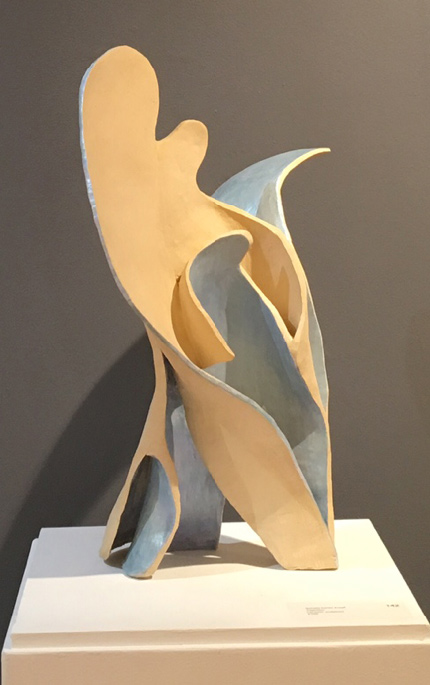
Natalia Koren Kropf, TOGETHER, Ceramic sculpture, 22”H x 15” W x 8”D
SB: If your basic nature was not to be interested in art, you could have gone into a different direction. But since you were drawing since before you could write, it was something in you that just needed to be coaxed out.
NK: Yes. There’s another thing I remember in my early youth. I was about thirteen. I gave a promise to myself that no matter what happens I will always be an artist. If someone would put me down or be very critical, I don’t get crushed. Thank goodness I realized it that early because I took it very seriously. Later in life when I doubted myself, I had to go on.
SB: I remember my teen years in California how intense one’s feelings were. I was taking art classes and theatre, and I would talk to my friends. Even if we didn’t know what would happen, we would congratulate ourselves at 16 or 17 that we would dedicate ourselves to the arts, almost like taking religious vows.
NK: Yes. There was an element of sacredness. Art was my sacred heaven. Growing up in the Soviet Union with no spiritual guidance, my family was my spiritual connection to Russia’s rich history. But in general, religion wasn’t there.
SB: It was discouraged.
NK: It was discouraged until about the late 1980s right after Perestroyka, and I began to help with restoration on the ancient archeological sites in Pskov. I also volunteered to clean up cathedrals and churches in St. Petersburg. I traveled a lot in the historical regions to paint remaining churches and monasteries not because I was religious but because of the architectural beauty of those ancient witnesses of history in the breathtaking surroundings of Mother Nature. Unfortunately, religious revival in Russia today takes its extreme form.
SB: In St. Petersburg, there’s that amazing cathedral…the one where Rasputin was murdered?
NK: Saint Isaac Cathedral.
SB: Yes, it’s overwhelming when you walk in there and see it for the first time.
NK: That cathedral was built by Auguste de Montferrand, a French Classicism architect, who worked primarily in Russia. The building is quite grand¬—as grand as it can be in the capital of the former Russian Empire. And besides that, all the excursions to the Hermitage for school projects made it feel like a second home. I knew it so well.
Most of my creative work was done at my uncle’s studio along with my aunt and cousins, all of whom were also painters. It was thrilling to work side by side with my mentor while he was composing his paintings and I worked on mine.
SB: When I moved to NYC in my twenties, I could go to the Met for a dollar or so donation. I felt so lucky.
SB: What were the circumstances, the deciding factors, of your leaving St. Petersburg for here? What propelled you?
NK: It was really my parents’ decision. I love St. Petersburg very much, and I loved friends I knew then. However, the political upheaval of 1991 left little hope for building the aesthetically-oriented future. The bank accounts were temporarily frozen. Art and artists were neglected. All cultural funding was cut off for an indefinite period of time. My parents filed papers for a political refuge. Our request was soon granted, and we were able to emigrate.
SB: What was it like for you when you arrived?
NK: When we arrived in New York, I fell in love with this cosmopolitan metropolis. My first job was copying the Old Masters at a fancy Art and Antique Gallery on Madison Avenue. I would not have dreamed of having a similar job in St. Petersburg at that time. I wanted to stay for a short while and return when things got better, but it turned out that the New York lifestyle constantly fascinated me and kept me going.
SB: So when you got the financial aid you needed, you went to Parsons School of Design.
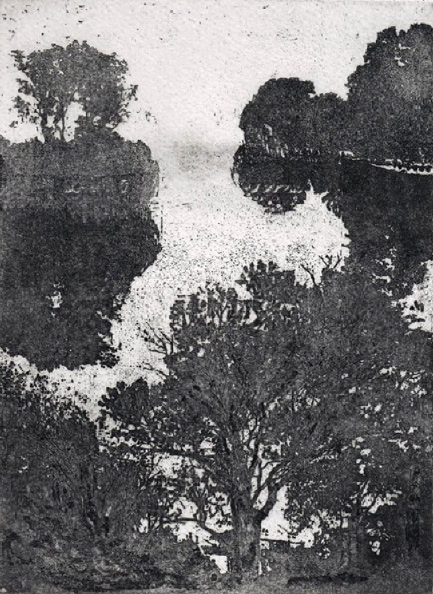
Natalia Koren Kropf, A QUIET HOUR, Etching, 6 x 9 in.
NK: While I was working in Tribeca in the fine art company, specializing in indoor murals and large-scale realistic painting, I wanted to study contemporary art, as it was not taught in Russia. My portfolio got me to Parsons. I got a merit scholarship. The remainder of the tuition I paid through a work-study program in the Adam and Sophie Gimbel Library’s Slide Collection at Parsons, where I was introduced to amazing artists and art history professors. Sharyn Finnegan, a member of the first Women Painters Co-op in SoHo, became a close friend. John Ross, who wrote the manual The Complete Printmaker, and Mohammed O. Khalil, an internationally renowned printmaker, were my teachers. The level of professionalism was what attracted me. I always had reverence to work on paper. At Parsons, I was able to learn the techniques and pursue my passion for the art of fine hand-pulled prints.
SB: After you graduated from Parsons, was it then that you met your husband?
NK: He was a friend of a friend. After we met, we went travelling until we decided to have kids.
SB: Travel can be a good way to discover if you’re compatible with someone. You have to have trust to decide to have a child.
NK: When we met, we just clicked together. I thought he’s the one who will be the father of my children.
SB: Once you knew he could be the other half of that process. Because all that time, your art was so important.
NK: He did not waiver. He held the crystal-clear intention of constant support and love. We are so lucky to have found each other.
SB: Let’s talk about your interest in teaching? Did you get a degree?
NK: Right after the graduation I was offered a teaching position at Parsons, Basic Drawing which I enjoyed before I had to stop to take care of my babies.
SB: But not for long?
NK: We bought a house in a beautiful Forest Hills, and my four-year-old daughter asked “Mom, why don’t you teach my friends to draw and paint?” Little by little, by word of mouth, I had twenty students. Fourteen years later Koren Kropf studio is still in business. Thanks to NAWA, I was able to show their work at the Gallery.
SB: You have two daughters.
NK: Yes. They are sixteen and eighteen years old now.
SB: When did you join NAWA?
NK: in 2010. I was in the group show at the Highland Cultural Center in Beacon, NY, and Susan Phillips, whom I just met there, suggested I apply to NAWA.
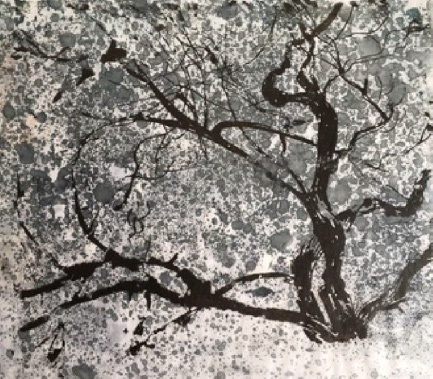
Natalia Koren Kropf, WET SNOW, Monotype, 2018, 14 x 14 in.
SB: That’s why it was so natural for you to do the NAWA workshops at the New York Public Library and a Children’s exhibit at the NAWA Gallery with your students.
NK: The first ever children’s exhibition at NAWA gallery was called Multiculture Multimedia. We were invited by Susan G. Hammond, the Executive Director, in 2012 and the second, Building and Bridges in 2017, at President Mary Alice Orito’s suggestion. Teaching feels to me like a direct continuation of the tradition that my grandfather started and my uncle developed.
SB: But you’re a very outgoing person. It was a natural progression for you. Your interactive connection with NAWA, the networking.
NK: I enjoy helping people to reconnect not only with each other but also with themselves through compassion and patience. It’s seeing the potential of things not only as they are but how they could be.
SB: One of your daughters has just been accepted into the School of Visual Arts.
NK: Yes. She will be the future director of animation! I am very proud of her choice to engage the fine arts of drawing and creative writing merged with sophisticated, cutting edge technology.
SB: I have to assume that with you teaching your girls, the interaction with your art, and being a mother and a wife…those challenges…it has been a positive thing, not a negative thing.
NK: I will be honest with you. There were days…(pause)…when I was washing dishes, thinking “I’m not born to do this.” I looked into ancient Eastern teachings for inspiration and then I completed a Kundalini Yoga Therapy degree to be a yoga teacher and therapist. Through that traditional lineage, I learned to do the chores humbly. It is like a form of meditation. I said to myself: “I can do dishes as my art of living. I can make art in everything I do – there is no separation.”
SB: Where does your work go in the future?
NK: Thanks to NAWA, I befriended many artists who inspired me. I always wanted to try sculpting, a painter’s secret. Once Anita Pearl, a sculptor and NAWA member, invited me to the basement of the Art Students League to see her work. I felt that there is room for me to grow right there. I have been working on ceramic sculptures for a few years, and now I’m working on my first bronze.
SB: It’s a whole different ball of wax from painting. Isn’t it? When I started at ASL a few years ago, I was with Mary Beth McKenzie at that time. I was a little intimidated because everyone was tending to paint her way or very academically. And I painted more stylistically. I just needed to find a different class. It’s that first brush stroke.
NK: That’s the way I paint too – a la prima. To me, it is like Zen calligraphy painting. This is your gesture. Only you can put it down like this.
SB: There’s a quote from Martha Graham I know: “Because there is only one of you in all time, this expression is unique.” In light of your role as the incoming president, have you given any thought about new directions or where we need to concentrate our energies?
NK: First of all, I would like to say how wonderful it is to work with Susan G. Hammond, NAWA Executive Director, and Jill Cliffer Baratta as a Vice President now. Together we make a great team. I would like to promote the public and online awareness of NAWA so when I say the name, people would know what the abbreviation NAWA stands for. And if they don’t know, they know they could easily look it up and be amazed by NAWA’s historical mission and the quality of the artwork throughout the130-year history.
SB: The newsletter is one way to spread the word. And the Annual is coming up.
NK: Yes. One Art Space on Warren Street in Tribeca is a great venue. The prospectus is sent out to the members, so please submit your best work. Not too large this time as the space is smaller than last year.
SB: Getting back to your plans for NAWA?
NK: Yes, number one is promoting NAWA and bringing NAWA into the 21st century. All NAWA shows, members’ achievements, educational programs, and the Fresh Paint program are reflected online, through the NAWA website, social media, newsletter, and individual artists’ posts referencing NAWA. The spreading of the word is already happening, I would like to see more #thenawa and #nawanews hash tags on the Instagram and Facebook tags @National Association of Women Artists, Inc. (Official) to attract curatorial cross-referencing, to expand our membership as well as the general audience. NAWA’s 2019 online shows have been successful. We are working on the online sales platform for our members. It will attract and is already attracting emerging women artists who are so eager to contribute to the NAWA mission with their talents.
SB: That’s not so ambitious, as long as we keep working no matter what.
NK: NAWA has so much potential, and the key to its power is in the group energy. Together we can make a difference.
NAWA SHOUT OUTS
MARY BURRELL
“I have built a collection of work that is known for its distinctive texture and shading, with attention to detail. Drawing is a form of meditation for me, and oddly enough, the more intense the drawing the more enjoyable.”
Mary lived in New York until August 2017 when she moved to South Carolina with her husband Mark. They have two daughters—Corianne from Denver and Katie from Philadelphia. Mostly a self-taught artist, she is always looking for new venues to explore. In New York, Mary worked for the Women’s Auxiliary Art Show for six years as well as being an active member of the Nyack Art Collective.
Her favorite medium is graphite pencil where she has developed her own technique, working with many layers. She also enjoys working with watercolor pencil, acrylic and watercolor paints. When choosing subject matter, the main thing she looks for is a challenge. “This is the way I can improve even if I fail. If I fail or succeed, I have always learned something.” She has a quote on her studio wall that reads: “You cannot learn from an empty canvas.”
Mary has obviously learned a lot, with her artworks exhibited in restaurants, libraries, galleries, public official offices and boutiques.
A member of the national organization, she is a generous contributor of NAWA’s newly inaugurated South Carolina chapter, as well as teaching Arts and Crafts to children at the local Cross Schools.
Her work can be seen on Instagram.
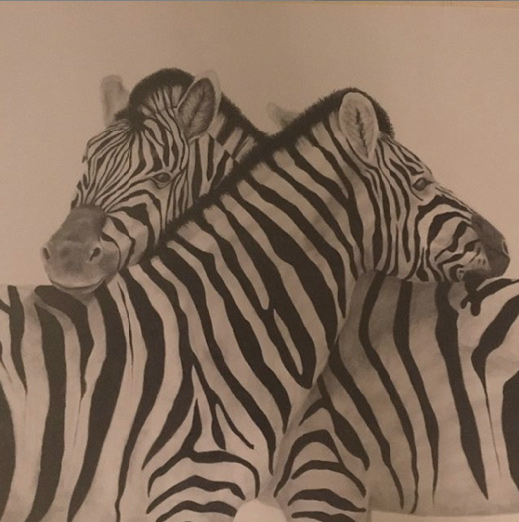
Mary Burrell, Zebra Love, Graphite pencil on paper.
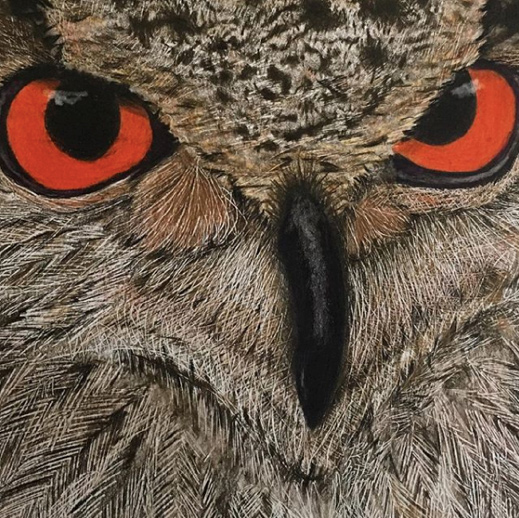
Mary Burrell, Scratch, Watercolor pencil on paper.
LISA GOREN
For the past 17 years, Lisa Goren has been a watercolorist with a mission – to bring the images of the frozen places of our planet to the rest of the world. As a polar and frozen landscape artist, she works in water to paint water and ice. Born in California and raised in NYC, she has been dreaming of polar landscapes since she was in her teens. Her first trip took her to Antarctica where she was inspired and captivated by the landscape. Later travels to Iceland, Alaska, and the High Arctic, near the North Pole, increased her love for the polar regions.
Her watercolors show an unfamiliar landscape in a new light. By using vibrant colors and taking risks with different surfaces, she makes the viewer reevaluate their understanding of both these landscapes and their beliefs in the potential of the medium. Her works create questions about the nature of abstraction and our planet as many of her pieces are representations of unfamiliar, threatened terrains.
Recently describing this as “an exciting time to be a watercolorist,” she has been experimenting with larger pieces (55” x 50” for example), different surfaces, and brighter colors. After an artist residency in Svalbard, she published an article about the trip in the New York Times (http://nyti.ms/1PAO5mr). In the past month, she has given a Google Talk at Google Headquarters in Cambridge, MA (http://bit.ly/lisagorengoogle) which has an audience of over 900,000.
When not writing or speaking about her work, she is trying to fit in as much time to paint with a family that’s readying to graduate their son from high school. “Looking forward to empty-nest-ville is a goal.” And she hopes to be able to show further afield from Boston—in NYC and beyond!
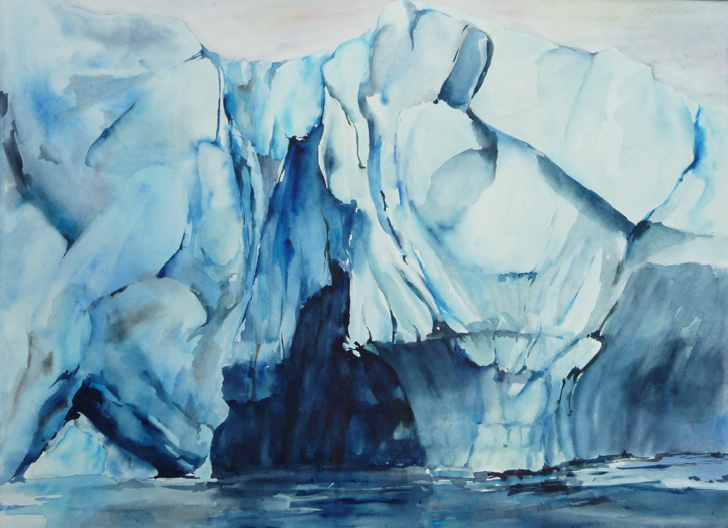
Lisa Goren, Blue in Antarctica, watercolor on paper, 22 x 30 in.
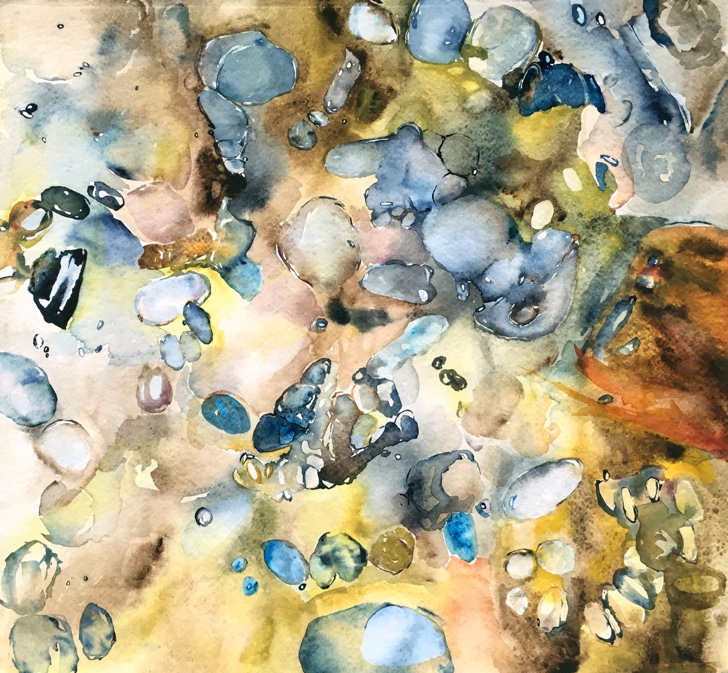
Lisa Goren, Bubbles in Ice, watercolor on paper, 18 x 18 in.
MELINDA WELKER
South Carolina Chapter Membership Chair
Melinda’s prior career as a news and culture reporter embraced, among other things, travel, lifestyle and cuisine. After retirement, her true passion for wildlife photography emerged. That passion has proved to be a true gift to all who have enjoyed her work. In her words, “I strive to capture the personality, behavior and beauty of birds as they go about their daily social behavior. Birds can be graceful, majestic, and sometimes downright funny.” She often studies their natural habitat. Her goal is to capture what people are unlikely to see every day, happily spending hours in a bird rookery, by a pond or in a wildlife sanctuary waiting to capture that unique shot. NAWA members are lucky to be the recipients of her discoveries.
In August, Melinda will be the featured artist at the Society of Bluffton Artists gallery where she exhibits her work. Her show, titled Come Fly with Me, will include more than 35 photographs of birds. Her work was recently curated into the annual Biennale exhibit on Hilton Head Island, SC, where 100 entries were chosen from among 700 entries submitted from across the United States.
As South Carolina Chapter Membership Chair, Melinda contacts deserving women artists to make application to NAWA. She says she makes an effort to attend art fairs and exhibits to learn about women artists outside her circle and introduce them to NAWA. While one goal is to bring more women into the SC Chapter, she also promotes NAWA to out of state artists she learns about through exhibits such as the recent Biennale.
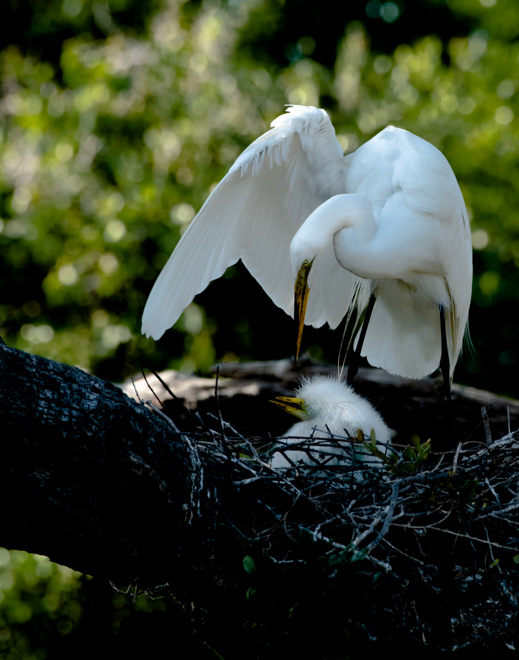
Melinda Welker, Great Egret with Chick, Digital photograph.
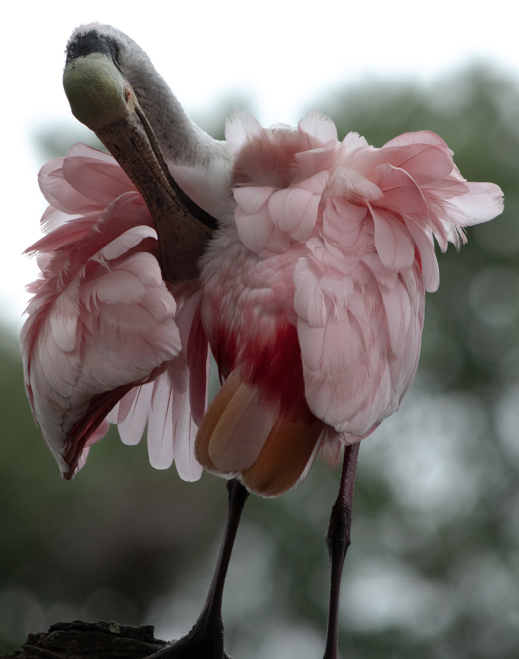
Melinda Welker, Preening Spoonbill, Digital photograph.
TOOLS OF THE TRADE
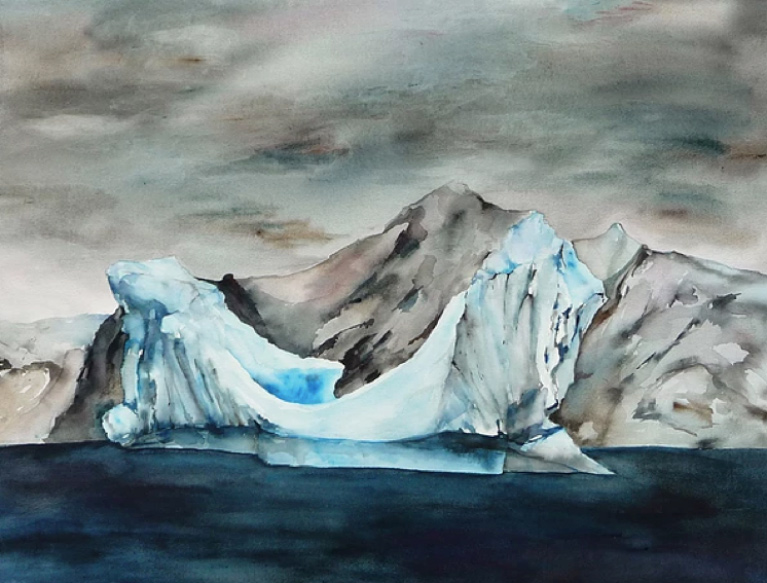
Lisa Goren, Iceberg from our Zodiac, #3, Watercolor on paper, 22 x 30 in.
Watercolor painting can be divided into several different approaches, all of which use water (the paint needs water to be activated). One of the most exciting (and daunting) ways to paint with watercolors is to use very wet paint with paper that has been doused with water – wet-on-wet. I have been working this way since I started with watercolors many years ago thanks to several teachers who showed me this method. The first “shocking” (to many of my students) thing that I do is that I never mix the paint on the palette. I always wet the paper and then add the paint and let the water and my brush help the colors find their place in the piece. To many painters, especially those who work with acrylics and oils, this seems like a crazy-loss-of-control process. But by using the water as my partner, I find that we are able to work together with enough control to make the pieces succeed.
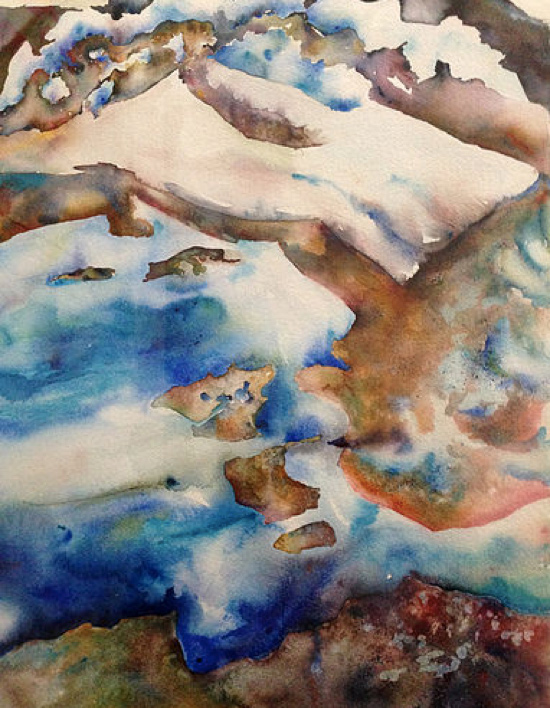
Lisa Goren, Antarctic Dessert, Watercolor on paper, 24 x 19 in.
Different paints have different reactions to the water, and it has taken some time to become familiar with each color’s personality. In particular, I use Sennelier paints which tend to explode more into the water once I’ve dropped it in. I love watching the paint find its way through the portion of the painting that I’ve wet. This could be a very fine line or half of the entire painting, depending on what I’m working on. Once you drop in two colors, then the magic happens with them dancing through the water to find their places. My brush is just an assistant at the beginning but then is much more important as the water and paint start to dry and I want them to inhabit a certain space.
Another factor in painting wet-on-wet is going to be the surface you use. I’m all for thinking outside the box on this. While I do use traditional paper (generally Fabriano, 300lb hot press), I will also work on Aquaboard (created for water media) or Clayboard (not made for water media) or artist panels that have been coated with white (also not made for water media). Each surface has its own personality, and working on them requires bringing a specific brain to the work at hand. Clayboard doesn’t absorb much – although more than Yupo (which I don’t really use). So when you’re working wet, you have to allow a lot of time for evaporation. It’s helpful to work on several pieces at once rather than waiting for a specific piece to dry.
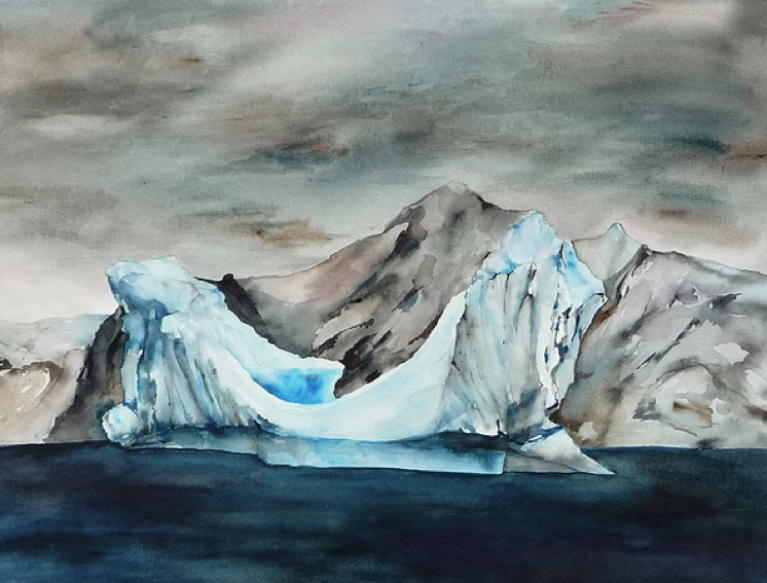
Lisa Goren, Jokulsarlon, Iceland, Watercolor on paper, 2016, 16 x 20 in.
Wet-on-wet watercolor is not the pristine, delicate process that many associate with the medium. By pouring, slapping, and spilling water onto the paper, the effects are unlike any that people often associate with watercolors. You get wet, and you get messy. But you get amazing results!
CHAPTER CHAT
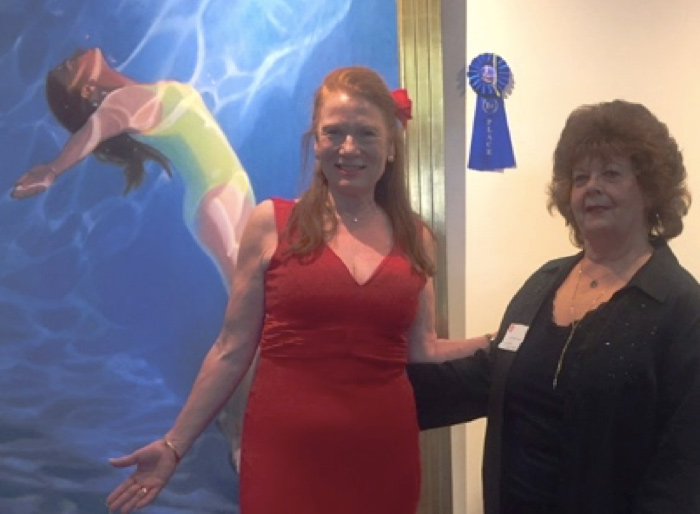
Candace Whitmore Lovely stands in front of her winning painting with Susan Hammond.
SOUTH CAROLINA CHAPTER
The SC Chapter had a successful exhibit entitled Transparency and Light in April at the University of South Carolina Beaufort Center for the Arts. Over a hundred guests enjoyed the opening of the beautiful exhibit which featured the art of the members of the chapter.
A few of the exhibit pieces were a tribute in memory of Mary Ann Putzier. Mary Ann was a beloved local artist that was juried into NAWA in the Fall of 2018 and passed away late last year. She referred to herself as a teacher first and artist second. Some of her beautiful work can be seen on her webpage.
Starting in the Fall of 2019 and continuing through Spring of 2020, the SC Chapter will be part of the Savannah Art Walk program. This monthly Art Walk will provide an opportunity for a selection of SC Chapter Members to exhibit in Savannah as well as to educate the public on NAWA.
The chapter also recently hosted a new member event where newly juried in NAWA and SC Chapter members shared some of their artwork.
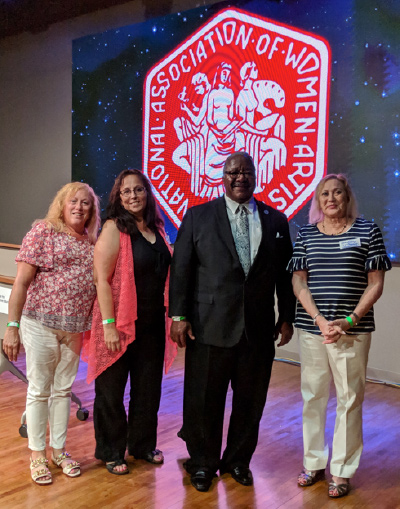
Left to right: Beth Scher, Roberta-Millman-Ide, Mayor Keith James, Karen Salup
FLORIDA CHAPTER
By Roberta Millman-Ide, President
On April 12, 2019, we enjoyed a very nice NAWAFL art reception for The Influence of Frida Kahlo on Contemporary Art at the CCE (Center for Creative Education), The Sallie & Berton Korman Gallery in West Palm Beach, Florida. In addition to our beautiful artwork that lined the Gallery walls, there was a Frida Kahlo documentary film playing in the CCE theater. We even had a surprise guest, West Palm Beach’s Mayor Keith James and his wife Lorna, attend our reception.
According to the CCE Marketing & Gallery Coordinator Jonathon Ortiz-Smykla, our exhibition was viewed by many visitors throughout the duration (April 8th-May30th), as it was coinciding with many other events surrounding Frida Kahlo’s life, art, and influence on artists. Our NAWAFL Vice President of Palm Beach County Exhibitions, Karen Salup, did a splendid job coordinating this entire show.
Our Award Winners were the following:
1st place – Jane McIntyre: Flight of Ideas-Graphite
2nd place – Pat Zalisko: Shaping Inferences-Acrylic on Canvas
3rd place – Anabel Rub Peicher: Homage to Frida Kahlo-Sculpture
Juror Recognition – Debbie Rubin: Blowing in the Breeze-Photograph
Juror Recognition – Karen H. Salup: Tie the Knot-Mixed Media on Canvas
I created an exhibition statement for this show that was used to both promote and inspire the viewer at our exhibition.
NAWAFL is now turning our sights toward our next exhibition: MS CONCEPTIONS. This Exhibit (which runs from October 2019 to January 2020) will be at the Marco Island History Museum & Gallery. Our Show will run concurrently with another important exhibition at the Museum, which has entered into an exhibition agreement with the Smithsonian Museum. During MS CONCEPTIONS, ancient artifacts recovered on Marco Island will be shown in the Historical Museum in the Gallery area of the Museum.
MASSACHUSETTS CHAPTER
by Kim Alemian, President
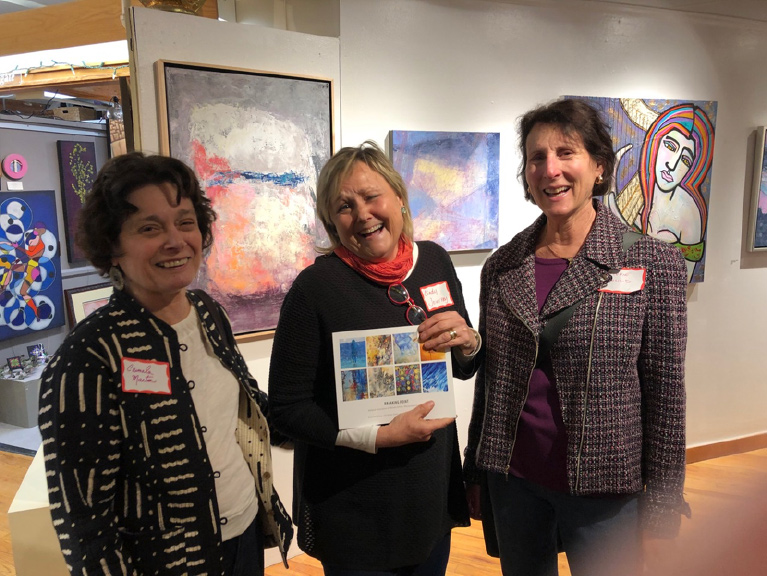
Left: Camela Marten, Cindy Journey, Ronnie Gould.
I am proud to announce that this is our second year offering scholarships to graduating high school students who are pursuing study in the arts. Two scholarships were awarded by our Scholarship Chair, Rosalie Cuticchia. She and Susan Siegel have worked tirelessly to get the word out to a wide pool of applicants. They have developed a rigorous and fair process for selection and have done a fine job in the selections.
Our upcoming Member Social will be held at Hospitality Chair Anita Cohen’s home. We will welcome new members and catch up with our seasoned members.
Co-Vice Presidents, Lisa Goren and Jennifer Jean Costello continue to have much success in offering their “Marketing your Art” and “Social Media for Artists” workshops as they stay on top of new developments in the field. Lisa is also making presentations for Sennelier watercolors and Fabriano papers. She was asked by Dick Blick to make the presentation in their Boston store!
Jennifer Jean Costello continues to forge ahead with finding exciting exhibition venues for us. We will end 2019 with 10 exhibitions! Breaking Point at the Brush Art Gallery just closed. There was a beautiful catalog that accompanied the show with a foreword by Gallery Director, Jim Dyment. Upcoming is an exhibition at the historic Rocky Neck Art Colony in Gloucester, MA, and we have opportunities for exhibitions at Boston Galleries and at the John Joseph Moakley United States Courthouse.
THE ART OF TRAVEL
By Pennie Brantley
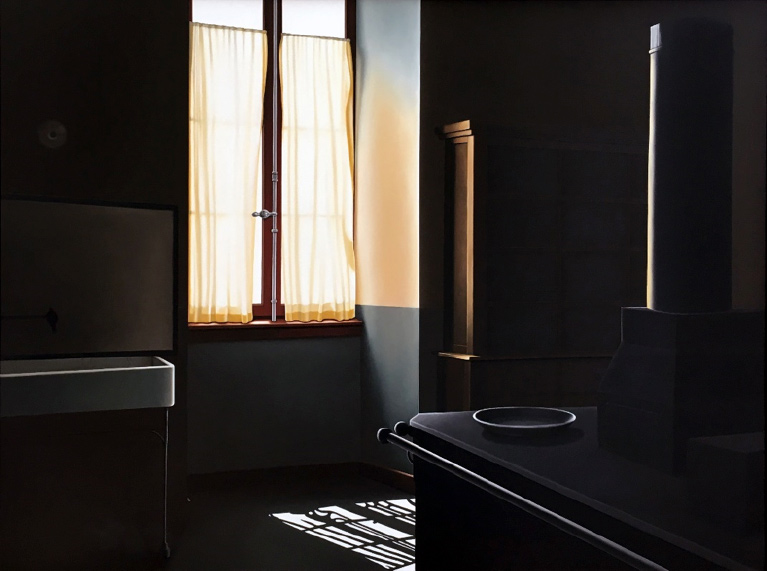
Pennie Brantley, Feeding Vincent (Kitchen at Van Gogh’s asylum, St.-Remy-de-Provence),
Oil on canvas, 36 x 48 in.
Fortunately, my husband Bob Morgan and I had been artists and travelers for years before we met—a perfect fit. We have lived abroad and explore overseas every year. An important element is always art—both visiting historical art places and finding inspiration for our own work. We have scoured Barcelona for every Gaudi and marveled at Mont-Sainte-Victoire on the Cezanne trail in Provence.
Of particular pleasure to us has been making pilgrimages to many places of import in Van Gogh’s life, especially in France (Arles, St.-Remy, Auvers-sur-Oise), Belgium (Mons, the Borinage), and the Netherlands.
On a recent trip to the Netherlands, we were in Nuenen to visit the Vincentre, which extensively details his life and work there from 1883-1885. The parsonage where he lived with his parents is across the street (now occupied, with no admittance). Its laundry room was converted to his studio. This is where he created his first famous masterpiece, The Potato Eaters, which we saw in person a few days later in Amsterdam. The location of the home of the De Groot family, who served as his models for that painting, is on the walking tour of the town.
Also nearby is the weavers’ cottage where he did a number of paintings and drawings, as well as the church he painted where his father preached. The center exhibits reproductions of his paintings with photos of the actual sites.
There are charts of Vincent’s family tree up to the present, with photos and articles of his descendants’ involvement with preserving his heritage. A statue of him was unveiled in 1984 by the Queen’s Commissioner.
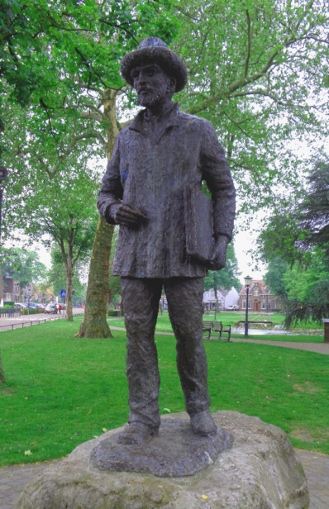
Bronze sculpture of Vincent Van Gogh
With the largest collection of Van Gogh’s work being in the Van Gogh Museum in Amsterdam, the second largest is 278 works in the Kroller-Muller Museum near Arnhem. It sits in a large nature preserve with a beautiful sculpture garden. Many other masters, such as Monet, Picasso, Braque and Mondrian are also in the museum. We especially enjoyed seeing Van Gogh’s Night Café from his stay in Arles, France. Years ago, we stopped in the café, which is now called the Vincent Van Gogh.
Besides our joy at experiencing the art and places of Van Gogh, a favorite on this trip to the Netherlands was The Hague. The exquisite Mauritshuis Museum has two rooms full of Rembrandts as well as many other masterpieces. Vermeer’s Girl with a Pearl Earring (c. 1665) is stunning. Bob and I were enchanted with his marvelous View of Delft (c. 1660). When we left The Hague, we detoured to Delft to find the spot where he painted The Little Street (now in Amsterdam’s Rijksmuseum) in about 1657. The buildings have since changed, but the location is identifiable. We were unaware that the street actually has a canal running through it, which is not seen in the painting.
Also in The Hague is the amazing Panorama Mesdag, painted in 1881, of the coastal fishing village of Scheveningen. A 395-foot circular canvas, it depicts a 360-degree view, enhanced by real sand and pieces of wreckage from the sea.
(Below: A section of the panorama)
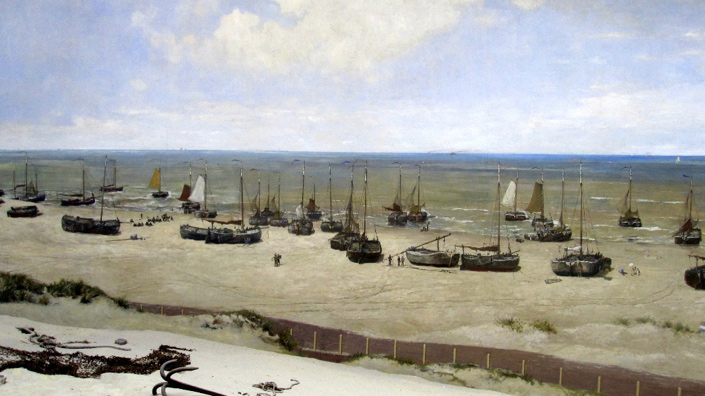
Hendrik Willem Mesdag, Section of Panorama Mesdag, Cylindrical painting, 1881
Nearby, the winter palace of the Queen Mother Emma houses the M.C. Escher Museum, which gave us a better appreciation of his work.
In Hertogenbosch, the Hieronymus Bosch Art Center occupies the former St. James cathedral. Excellent replicas of his entire oeuvre are the actual size of the originals, many of which we have seen elsewhere. 3-D figures of strange creatures from his paintings are scattered throughout the museum and the town. Amsterdam’s Rembrandt house, the Stedelijk and Rijksmuseum, plus the Fran Hals Museum in Haarlem, were also on the agenda. All glorious.
A very personal experience was particularly special for me. On our last visit to Amsterdam in 2005, I snapped a quick shot of a unique house on a canal cruise. It had white curtains billowing out its windows. I felt impelled to paint it after returning home. Taking another canal ride this time, we hoped to see the distinctive house I had spent long months painting. We spotted it! I marked it on a map.
We walked to the house the next day with a blurry, quickly-made copy of the painting from my website in hand. To our surprise, the building is occupied by an important international arts organization. They invited us in and showed us around the building, happy to receive the blurred copy of the painting. Even more surprising was to learn that the billowing curtains were a temporary art installation. It was fortunate for me to have seen it then! These very nice people gave us an English copy of a book on transatlantic art and culture, with essays from experts all around the world. Yesterday, I sent them each a non-blurry poster of my painting.
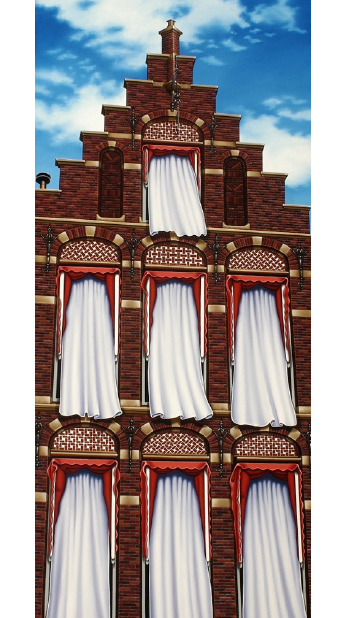
Pennie Brantley, Private Lives (Amsterdam Canal House), Canal House, Herengracht 415, Amsterdam. Oil on canvas, 54 x 24 in.
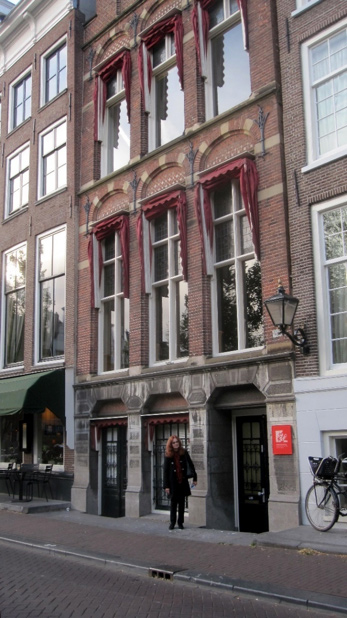
Canal House, Herengracht 415, Amsterdam
NAWA READS
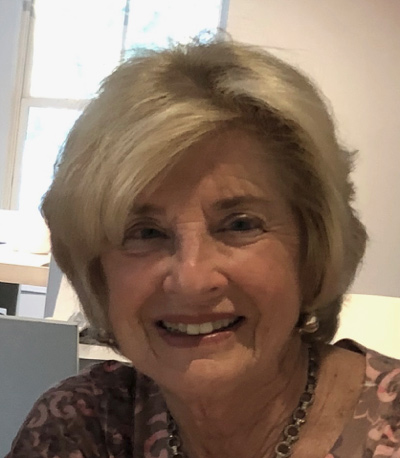
Nancy Vineburgh
By Nancy Vineburgh
NAWA NOW is delighted to introduce a new book review column by Nancy Vineburgh, which should be of much interest to the readers among us. Nancy is a member of NAWA’s South Carolina chapter. She resides in Bluffton, SC and is active in the arts community there as a member of the Society of Bluffton Artists and Art League of Hilton Head, where she has had two featured artists exhibits. She also founded the Belfair Art League. Nancy has earned numerous awards for her communication skills in both the public and private sector throughout her career. For her first review, she has chosen The Other Alcott, a book about the artist and sister of author Louisa May Alcott. It’s an under-the-radar story we hope our members will find particularly intriguing.
The Other Alcott, Elise Hooper
William Morrow, 2017
Eclipsed by her famed older sister, author Louisa May Alcott, May Alcott pursued a career as a woman artist during the period of time that foreshadowed the 1889 founding of NAWA. The Other Alcott presents the untold story of May’s artistic journey from 1869 to her untimely death ten years later (a complication of childbirth). During this decade, May traveled from Boston to London, Rome and Paris, achieved acceptance to display her paintings in the 1877 and 1879 Paris Salon, enjoyed a productive record of sales, and befriended some of the period’s most renowned women artists, among them Mary Cassatt.
Despite Boston’s limited art instruction for women in the 1860s, May studied under the highly influential Dr. William Rimmer and William Morris Hunt whose assistant, Helen Knowlton, an artist in her own right, inculcated the importance of traditional drawing techniques as a prerequisite to oil painting.
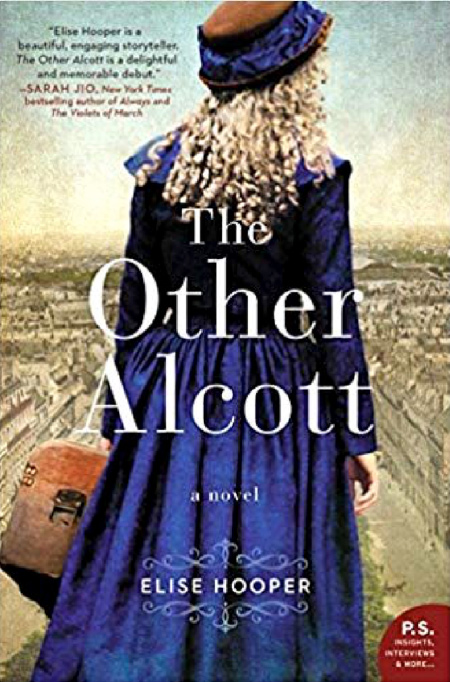
Cover art, The Other Alcott by Elise Hopper.
A fateful turning point in May’s career occurred in March 1874—a chance meeting with John Ruskin, Victorian art critic and Trustee of J.M.W. Turner’s art collection at the National Gallery in London. Ruskin was so impressed with May’s renderings of Turner’s work, he referred her to several gallery owners, who purchased her copies and some of her original florals on consignment. Able to pursue her art and travel through Louisa’s publishing income and loving support, sales from these and subsequent pieces of her work enabled May to achieve a heretofore unthinkable financial independence.
At 38, May married Ernest Nieriker, a Swiss business man sixteen years her junior. They moved to Meudon, France on the outskirts of Paris where May resumed her painting at Academie Jullian. There she painted La Negresse, accepted by and hung in the Salon of 1879. Soon thereafter, she delivered a baby girl affectionally known as Lulu. May tragically died six weeks later from a contracted infection. Such early complications from childbirth were not that unusual in those times, and sadly enough, cut short a rare and promising artistic career.
May also published a book under her married name, Abigail May Alcott Nieriker, Studying Art Abroad, and How to Do It Cheaply. The book sought to empower women artists, especially those like herself with limited financial resources.
The Other Alcott is a work of historical fiction. Its author, Elise Hooper, relied upon primary sources including May’s unpublished diary to accurately depict the ‘contours’ of May’s life. Literary license was taken with the ‘context’ of her journey. While May’s friendship with Mary Cassatt was real, her encounters with some important women artists of the period were invented. These include Elizabeth Jane Gardner of Exeter, New Hampshire, who became the wife of William-Adolphe Bouguereau; Anne Whitney, the American sculptor whose work reflected her views on abolition and women’s rights; and Anna Klumpke, a landscape painter and portraitist as well as the life-long partner of French artist, Rosa Bonheur.
The Other Alcott raises awareness of the complex challenges that 19th and early 20th century female artists experienced financially, socially and professionally. How to financially support and sustain one’s art including instruction that frequently necessitated European travel; how to gain recognition in an art world shaped and run by men; and, how to—or even if—to combine marriage and career (Berthe Morisot apparently did so successfully).
NAWA SC chapter member, artist and art instructor Joyce Nagel points out that “May’s art education emphasized drawing, anatomy and practice, practice, above and before painting.” Joyce, who enjoyed the book immensely, shares May’s birthday, July 26, “just 100 years later!”
Pat Zirpolo, Orchard House scholar and docent, finds The Other Alcott to be very readable as fiction. She takes issue with the book’s portrayal of the relationship between Louisa and May, both of whom were very dear to each other. According to Pat, “The biggest surprise to most visitors to Orchard House, home to Louisa May Alcott and her family, is that May Alcott was such an accomplished artist. Much of May’s original work is on the walls of her bedroom, in the studio her family built for her, and hanging on the walls of all the rooms. Pat feels sure that “May and Louisa would both applaud the work of American women artists today and the National Association of Women Artists.”
EXHIBITS ON YOUR RADAR
Lorna Simpson: Darkening
Hauser & Wirth, April 25 – July 26, 2019
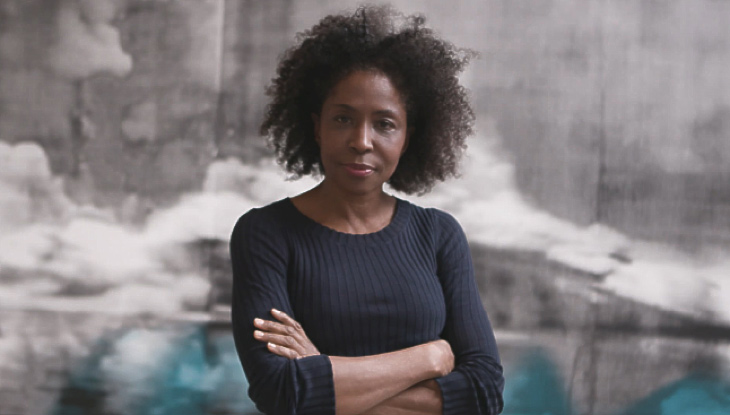
Lorna Simpson pictured in her Brooklyn studio, 2018. From the video tilted Lorna Simpson: In the Studio
Some artists take us fearlessly into the heart of things—think of Georgia O’Keefe’s white camellias or a cow’s bleached skull—and succeed. Lorna Simpson’s glacial paintings are a revelatory journey into the darkest blue recesses of the arctic. These paintings, some nine feet high, are made of ink and gessoed fiberglass or wood and speak volumes about a world of water and air that surrounds us.
Other pieces are centered on the faces of figures who read as Black women, above the water with deeper primal meanings that lie below the surface. After three decades of risk-taking, defiant, conceptual creations—utilizing photography, collage, film, sculpture, installation and more—she has taken up painting. What’s next? We wait with bated breath.
Lorna Simpson. Darkening continues at Hauser & Wirth, 548 West 22nd Street, Chelsea, Manhattan, through July 26th.
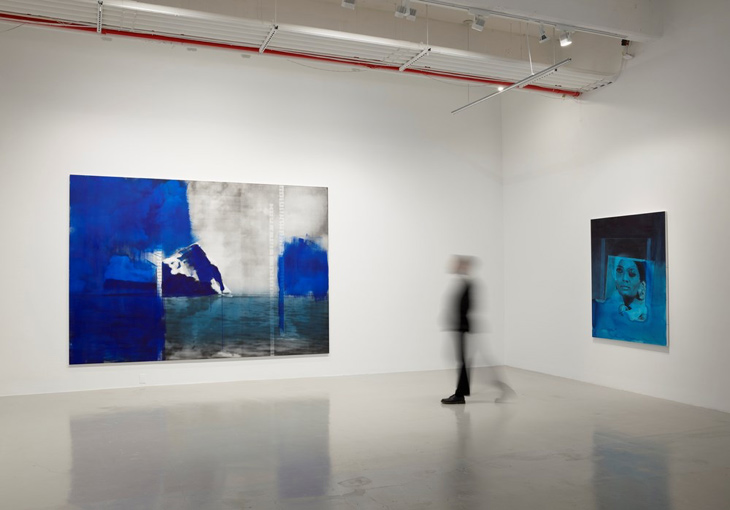
Exhibition view: Lorna Simpson, Darkening, Hauser & Wirth, New York © Lorna Simpson.
Courtesy the artist and Hauser & Wirth.
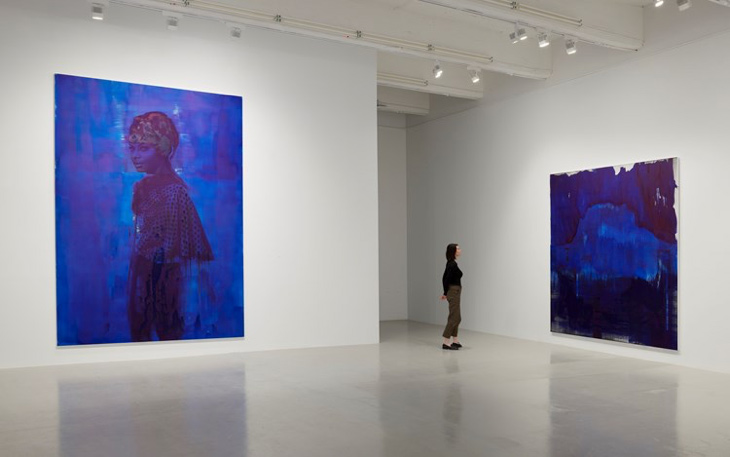
Exhibition view: Lorna Simpson, Darkening, Hauser & Wirth, New York © Lorna Simpson.
Courtesy the artist and Hauser & Wirth.
Angela Dufresne: Just My Type
Samuel Dorsky Museum of Art
February 9 – July 14, 2019
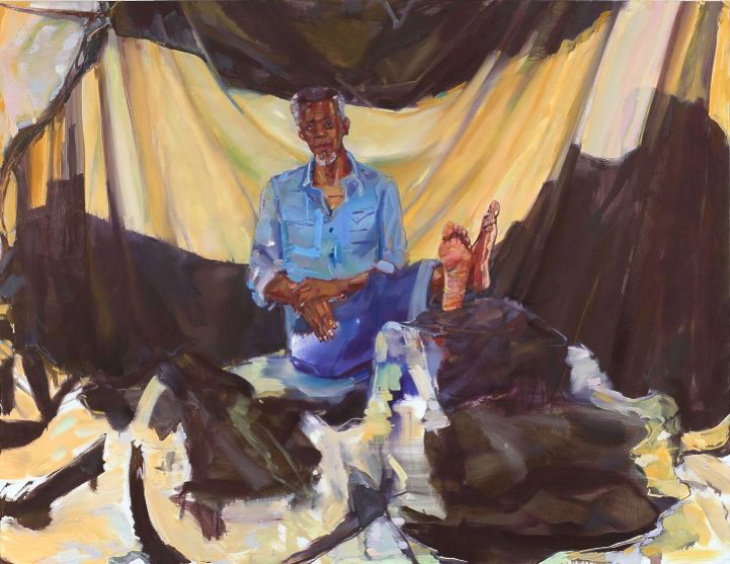
Angela Dufresne,Dean Moss, oil on canvas, 2017, 5 x 7 ft.
Some of the best portrait painters don’t apologize. What you see is not just what you get, but what the artist wants you to see. And it’s often not pretty. Just think of Francis Bacon, Lucian Freud, and Alice Neel. There’s another name you should know: Angela Dufresne. Her show, Just My Type: Angela Dufresne, is currently at the Samuel Dorsky Museum of Art, State University of New York New Paltz through July 14.
Growing up in Olathe, Kansas, this 50 year-old painter has been drawing grotesque figures since childhood. Not simply imagining a transgender body, she evokes a post-human one. Her large-scale oils often depict her loved ones, expressing gender ambiguity in a collaborative process. Her subjects will suggest how they see themselves, providing backdrops and identity suggestions, from a Felliniesque gigolo to a beheaded John the Baptist. She is not afraid to make reference in the compositions of Velasquez, Goya and Gainsborough among others. There’s a fine if disturbing intelligence at work here.
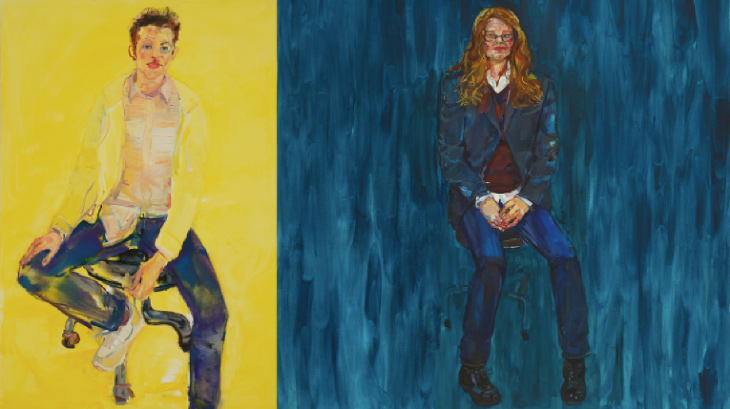
Angela Dufresne, Kerry Downey, 2016, oil on canvas, Nicola Tyson, 2017, oil on canvas, courtesy the artist
UPCOMING NAWA EXHIBITIONS
SUMMER SMALL WORKS
NAWA Gallery
315 West 39th Street, Suite 508
New York, NY
July 7 – August 1, 2019
Reception: July 18, 5-7pm
BEAMESDERFER 4: REAL/UNREAL
B. Beamesderfer Galler
6 North Second Ave, Highland Park, NY 08904
September 5–October 31, 2019
Reception: September 5, 6 – 8pm
PHOTOGRAPHY (LIGHT & LENS)
NAWA GALLERY
315 West 39th Street, Suite 508, NYC
September 11 –October 2, 2019
Reception: September 18, 5 – 7pm
130TH ANNUAL MEMBERS’ EXHIBITION
One Art Space
23 Warren Street, NYC 10007
September 21 – October 1, 2019
Reception: September 21, 6 – 8pm
Art Angels
NAWA GALLERY
315 West 39th Street, Suite 508, NYC
Oct 9 – Oct 30, 2019
Reception: Sept 18, 5 – 7pm
NEW MEMBERS’ EXHIBITION
NAWA GALLERY
315 West 39th Street, Suite 508, NYC
November 6– June 28, 2019
Reception: November 14, 3 – 5pm
JOYOUS LIGHT
Edward Williams Gallery
Fairleigh Dickinson University
150 Kotte Place, Hackensack, NJ
November 18, 2019– January 10, 2020
Reception: TBA
PRINTMAKING & ENCAUSTIC PAINTING
NAWA Gallery
315 West 39th Street, Suite 508
New York NY 10018
December 11, 2019 – January 3, 2020
Reception: December 18, 5-7pm
WHO’S ON BOARD
Joan L. Lewis
I had a rather inauspicious start to my art career. In grade school (many decades ago), I faced my first, and harshest, art critic—my kindergarten teacher. One day, she handed each of us a plaster mold of a flower, and told us to paint the flower. I painted my flower black. With a flourish of her hand, my teacher tossed my flower in the garbage pail and announced, “Flowers aren’t black.” My second art project did not fare much better. This same teacher (she will remain nameless) gave each of us a picture of a tree and instructed us to color in the leaves with crayon. I colored the leaves of my tree black. Again, in the garbage pail it went. But this time, she also called my parents in for a talk. Much to her consternation they told her that they did not think there was anything wrong with my color choices.
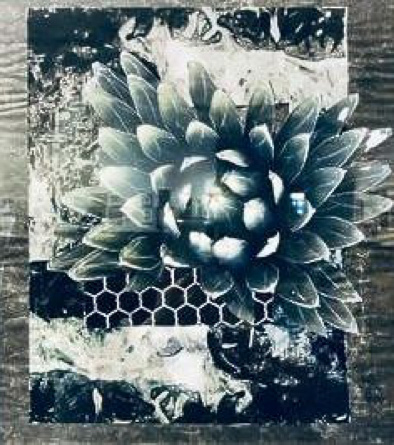
Joan Lewis, Fenced In, Collage on paper, 2019.
Notwithstanding my teacher’s withering view of my artistic skills, my mother enrolled me in Saturday morning art classes at the local “Y.” I loved these classes, and I can still remember the smell of paste as I ran up the stairs to the art studio each Saturday morning. My love of the art studio continued all through my grade school and high school years. In high school, I was fortunate to have an inspiring art teacher who encouraged my non-conventional use of colors and materials. In my senior year, I was rewarded for my efforts when one of my paintings was selected for inclusion in an exhibition of New Jersey artists held in the New Jersey State Art Museum. It should be no surprise that my painting was primarily black. While I loved making art, I never had the confidence to call myself an artist.
College, law school and then my career as a trial lawyer took me away from the art studio for many years. I did manage to squeeze in an art class at night from time to time. I tried different classes—ceramics, beading, drawing, metals. But for the longest time, nothing really clicked for me. And I certainly did not have the confidence to call myself an artist.
Eventually, I found my true passion: collage. I love the process of building a collage, piece by piece, and layer by layer until it tells a story. Upon retirement several years ago, I turned my attention to pursuing this passion. I find that my way of looking at the world around me has shifted. Like most urban dwellers I used to see the City strictly in terms of its buildings, cars, streets, people, etc. I now see it in terms of patterns, textures, colors and movement. I also have developed the habit of constantly surveying the sidewalk and the curb when I am out walking. After all, another person’s litter is, to me, potential treasure . . . material that could be used in a collage! My husband and friends have become accustomed to seeing me stop dead in my tracks, reach down to the pavement and put in my pocket such detritus as an empty cigarette package, a discarded laundry receipt, or a tattered grocery list. I still, however, felt the weight of my failure as a kindergarten artist, and did not have the confidence to refer to myself as an artist.
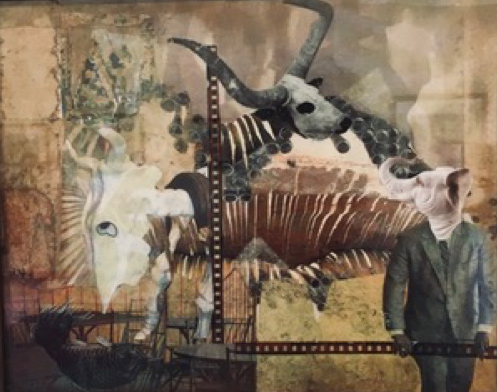
Joan Lewis, The Dream, Collage.
A few years ago, I became a member of NAWA’s Executive Board of Directors and Chairperson of its Nominating/Governance Committee. I had retired from practicing law and was looking for an opportunity to contribute some of my time and experience to a non-profit arts organization. A printmaking teacher, who happened to be on NAWA’s Board of Directors at the time, suggested that I consider joining the board. I was not familiar with NAWA at that time, and so I did some research. I was shocked to learn how underrepresented women artists are in galleries, museums, and private collections. I saw the importance of NAWA as an agent of change for women artists and thus agreed to submit my name to the board for their consideration. Much to my delight, the board approved my candidacy, and I have served as a member of the Executive Board ever since.
I am proud to contribute my time to this venerable,130-year old institution. I feel that it is my duty as a board member to do my part to see that NAWA continues its important work for another 130 years, or until the art world recognizes women artists as equal to their male peers. I have been so impressed by the dedication of NAWA’s officers, directors, staff, volunteers and members who give tirelessly of their time to ensure that women artists have opportunities to show their work and advance their careers.
As a postscript, notwithstanding my penchant for painting flowers black, NAWA recently invited me to become an artist member. At first I demurred, lacking the confidence to call myself an artist. But then, I decided to accept the invitation. When I walked across the stage during my induction ceremony, this past November, I felt, for the first time, that I could say aloud, “I am an artist.”
EVENTS
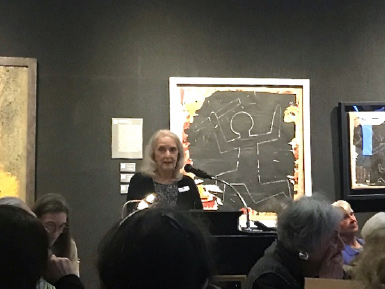
Joan Semmel, NAWA Annual Luncheon, National Arts Club, NYC.
NAWA Annual Luncheon
May 9, 2019
The Annual Luncheon on May 9, 2019 was a very special occasion to celebrate Joan Semmel, one of the leading painters and feminists in the nation. Often mentioned in the same breath with Judy Chicago, Marilyn Minter and the Guerilla Girls, Joan is primarily a consummate painter, with a transformative vision of the human figure. At 87 years young, she continues to inspire and astound us with her works. Held in the historic and beautiful National Arts Club, the luncheon proved as always to be a moving and unforgettable experience. It was also an opportunity for members to meet our new incoming President, Natalia Koren Kropf and welcome our outgoing president Jill Baratta as she assumes the role of NAWA’s Vice President. Together they will make a terrific team, carrying on NAWA’s mission into the twenty-first century.
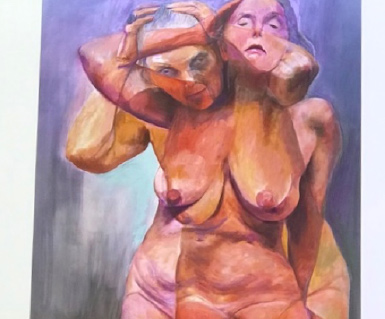
Joan Semmel projects her painting on screen at NAWA Annual Luncheon.
With over 800 active members in NAWA, the variety, eclecticism and downright talent of the membership deserves to be displayed to its ultimate advantage. In honor of this diversity, as a way of celebrating our 130th year in existence, the NAWA gallery has featured a rich sampling of styles and mediums representative of these artists each month.
January brought us a beautiful watercolor show you can find more about in our April issue. February followed the tradition of our Winter Small Works exhibitions, with the added enticement of an online show of Women Celebrating Women. March gave a full range of Collage and Digital arts experts among us. April came marching in full force with a bold showing of Acrylic and Oil Painting; May followed with a perfect spring outpouring of Drawing and Pastel. Not to be outdone, 3D Wall and Pedestaled Sculpture artists took precedence in June. In July, the walls will be filled with a dazzling example of Summer Small Works.
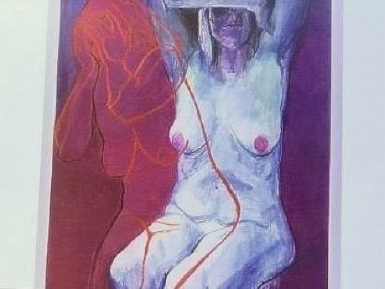
Joan Semmel projects her painting on screen at NAWA Annual Luncheon.
While you’re catching your breath, don’t let the lazy days of summer make you miss the photography show on view in September. Before the month is out, the excitement of this year’s Annual at One Art Space in the heart of Tribeca’s art scene will draw many of us throughout the country to exhibit our best work.
We urge you to keep up with NAWA’s website, www.thenawa.org. It’s one of the most important places to keep up to date with your fellow artists!
RECENT MEMBER SOLO AND TWO-PERSON EXHIBITS
Harriet Livathinos and Reidunn Fraas
Abstract Explorations
Art Bar Gallery
674 Broadway
Kingston, NY
Saturdays, June 1 – June 30, 2019
Diane Salamon
Living Resolutions
Kansas City Arts Coalition
201 Wyandotte St, Kansas City, MO
June 7 – June 28, 2019
CURRENT/UPCOMING MEMBER SOLO AND TWO-PERSON EXHIBITS
Carol Nipomnich Dixon
Paintings and Embroideries
Byram Shubert Library
21 Mead Avenue
Greenwich, CT
July 6 – July 27, 2019
Reception: Saturday, July 27, 2019
Marieken Cochius & Carol Kunstadt
Natural Inclinations
Art Bar Gallery
674 Broadway
Kingston, New York
July 6 – July 27, 2019
Reception: July 6, 5:00 – 9:00 pm
Nancy Staub Laughlin
Pastel/Photographs: Assemblages
The View, Vandervort Gallery
Central Adirondack Region
Old Forge, New York
July 27 – September 15, 2019
Reception: TBA
Veronica Yaeger
Bound to Pop
K Space Contemporary
415D Starr Street
Corpus Christi, TX
June 7 – July 26, 2019
PUBLICATIONS
CO-EDITORS SANDRA AND MIMI
By the time you read this, summer will be in full swing and many of you will be painting, sculpting and snapping (and maybe even dancing!) to its beat. In this issue of NAWA NOW, we hope you enjoyed the interview with our new president, Natalia Koren Kropf. Born in St. Petersburg, Russia, she shares fascinating details of her life in art—emigrating to the United States, raising her two beautiful daughters, as well as her current, and future plans for NAWA.
Other exciting news to keep you digesting: Pennie Brantley brought us news of her recent trip abroad, tracing the haunts of Van Gogh, among other sites. In Tools of the Trade, you can cool down with Lisa Goren’s advice as a frozen landscape watercolorist, and what she has learned over a 17-year career interpreting icy climes. Nancy Vineburgh introduced a new feature, NAWA Reads, with a review of The Other Alcott—an historical fictional account of the brilliant and talented painter May Alcott, sister of the author Louisa May, whose life was crisscrossed with the likes of Mary Cassatt and John Ruskin.
And there’s more about the women and events that make up our amazing membership roster, of which you are an integral part. Lastly, don’t forget to submit to NAWA’s 130th Anniversary Exhibition, to be held at One Art Space in NYC’s Tribeca, the prime location for the gallery-going public, September 21-October 2, 2019, with a reception Thursday, September 26. You can find the full prospectus at www.thenawa.org. Remember, there’s no time like the present!
And don’t forget to keep in touch with us about the art in your life.



